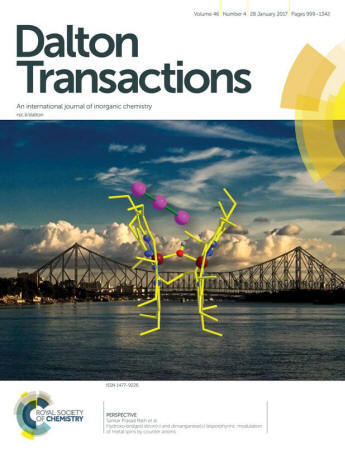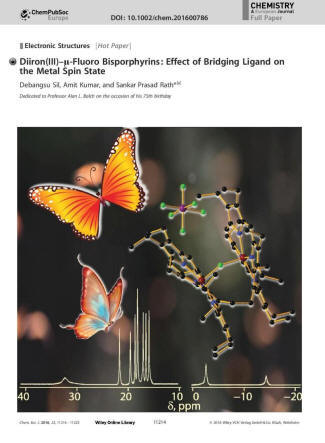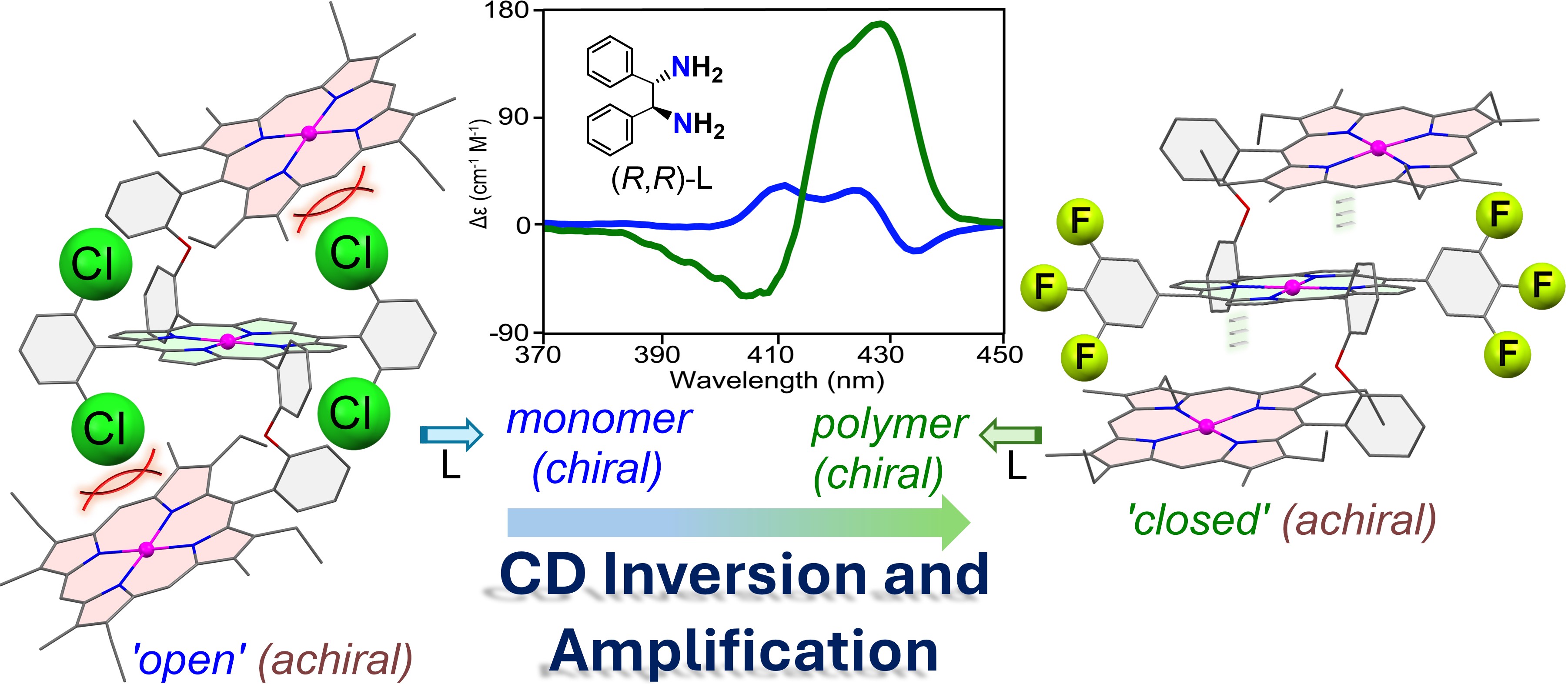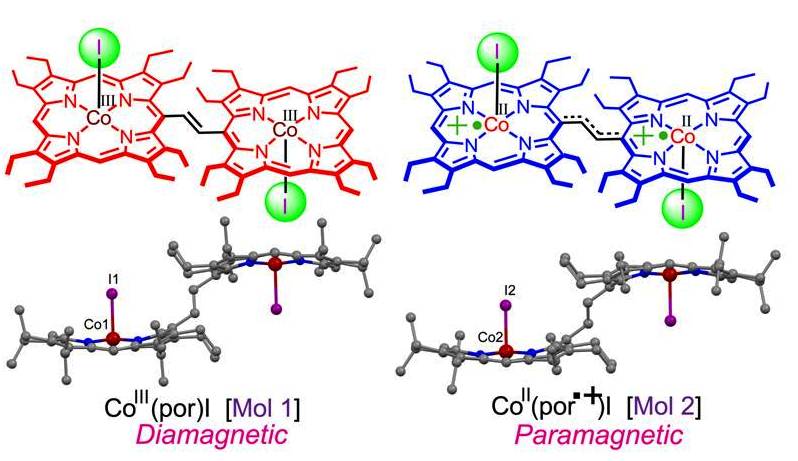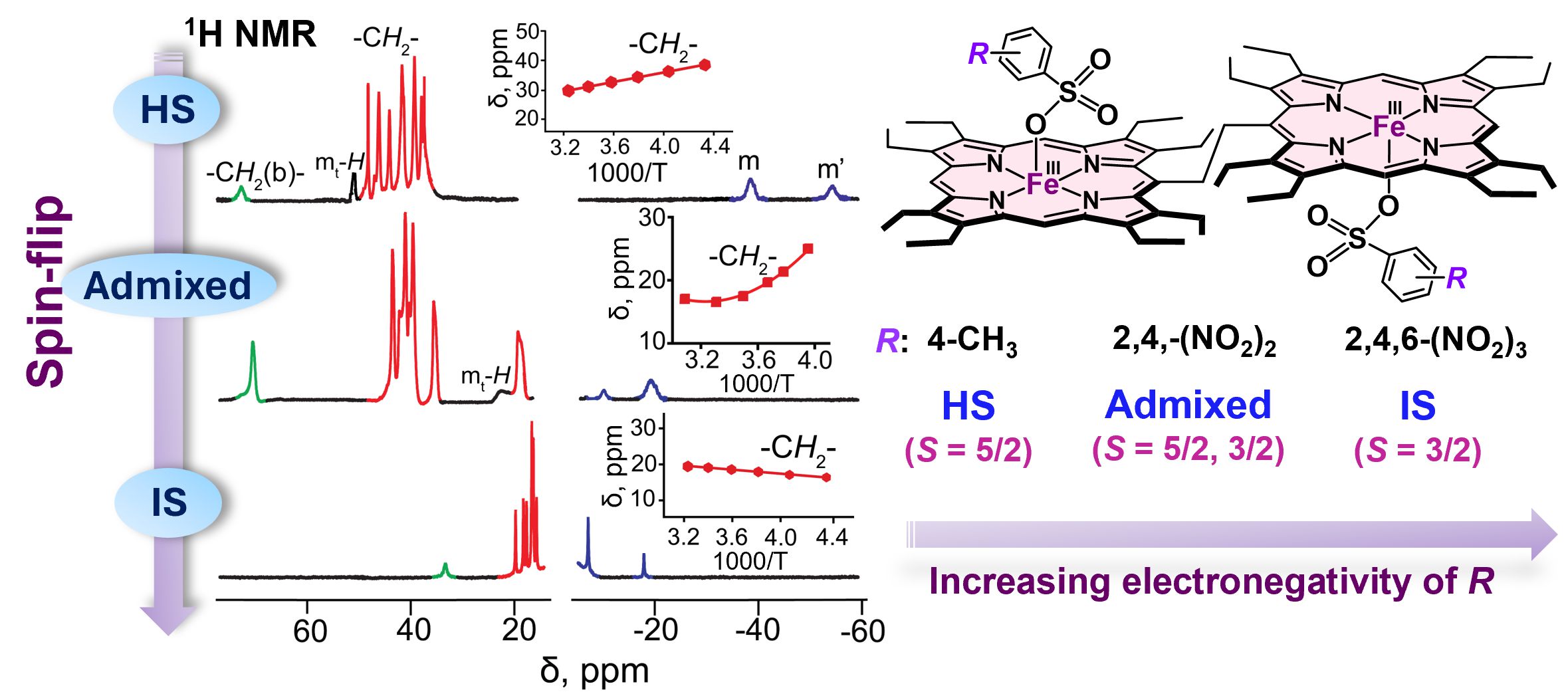

Bioinorganic Laboratory
Department of Chemistry
Indian Institute of Technology Kanpur
Full List of Publications
|
|
|
Complete List of Publications:
145. Impact of Structural Subtleties on Chirality Induction and Amplification in Trizinc(II)porphyrin Trimers
D. Chandel, C. Pal and S. P. Rath*
Chem. Eur. J. 2025, 31, 0000. Full Article
A subtle modification in a ‘nano-size’ trizinc(II) porphyrin trimer profoundly affects its complexation and chirogenic responses with chiral diamine substrates: while ‘open’ form generates ‘monomeric’ complex with low CD amplitude, ‘closed’ form produces exclusive ‘polymer’ with large, amplified CD signal with opposite sign.
144. Modulating Magnetic Exchange, Spin Dynamics and Intermacrocyclic Interactions via an Oxo-bridge in Dihemes Through Stepwise Oxidations
S. Banerjee, R. K. Tiwari, P. Chakraborty, G. Rajaraman and S. P. Rath*
Inorg. Chem. Front. 2025, 12, 0000. Full Article
A bis-Fe(III)-µ-oxo-porphyrin dimer where the two porphyrin units are covalently bridged by a rigid ethene linker has been utilized to modulate the spin coupling upon stepwise oxidations. There has been a large decrease in the magnetic exchange interaction (J) between the Fe metal centres upon 1eˉ-oxidation followed by a sharp increase again upon 2eˉ-oxidations. This has resulted in the downfield shift in the paramagnetic 1H NMR spectra followed by an upfield upon 1eˉ and 2eˉ oxidations, respectively.
143. Probing Substrate Binding inside a Paramagnetic Cavity: A NMR Spectroscopy Toolbox for Combined Experimental and Theoretical Investigation
S. Sarkar, C.-Q. Wu, S. Manna, D. Samanta, P. P.-Y. Chen and S. P. Rath*
Chemical Science 2024, 15, 17407–17417. Full Article(EDGE article)
(Invited article for the Spotlight Collection on Bioinorganic Chemistry)
A covalently linked Fe(III)porphyrin dimer-based paramagnetic sensory cavity is designed for an accurate detection and simultaneous identification of substrate binding inside or outside the paramagnetic cavity that provides a unique spectroscopic signature with valuable structural and environmental information. These substrates within the paramagnetic cavity leave the fingerprints of the specific binding modes (exo vs. endo) in various spectroscopic studies viz. UV-vis, 1H and 19F NMR and in their respective crystal structures.
142. Unusual Stabilisation of Remarkably Bent Tetra-cationic Tetra-radical Intermolecular Fe(III) µ-oxo Tetranuclear Complexes
S. Sarkar, R. K. Tiwari, D. Samanta, T.Guchhait, E. C.Sañudo, G. Rajaraman* and S. P. Rath*
Angew. Chem. Int. Ed. 2024, 63, e202402344. Full Article(HOT Paper)
A hitherto unknown series of air stable, π-conjugated, remarkably bent tetra-cation tetra-radical intermolecular µ-oxo tetranuclear complexes has been reported and structurally characterised. These species facilitate long-range charge/radical delocalisation through the bridge across the entire tetranuclear unit, manifesting unusually intense NIR bands. Assorted spin states of Fe(III) centres are stabilised: terminal six-coordinate iron centres stabilise the admixed-intermediate spin states, while the central five-coordinate iron centres stabilise the high-spin states. A strong exchange coupling among the centres, coupled with the bent nature of the Fe-O-Fe moiety, promotes intense NIR bands.
141. Conformational Switching of a Nano-Size Urea-bridged Zn(II)Porphyrin Dimer by External Stimuli
B. Saha, C. Pal, H. Malik, T. G. Gopakumar and S. P. Rath*
Chem. Eur. J.2024, 30, e202402536. Full Article
(Invited article in a Special Issue dedicated to Prof. G. K. Lahiri on the occasion of his 65th birthday)

Explicit stabilization of the (cis,cis), (cis,trans) and (trans,trans)-conformers of a ‘nano-sized’ highly-flexible urea-bridged Zn(II)porphyrin dimer have been achieved via careful manipulations of external stimuli viz. solvent dielectrics, temperature, anionic interactions, axial ligation and surface-mediated stabilization. The conformers differ widely in their structures, chemical and photophysical properties and thus have wide applicability.
140.
Bridge vs. Terminal Cyano-coordination in Binuclear Cobalt Porphyrin Dimers: Interplay of Electrons between Metal and Ligand, and Spin-Coupling via BridgeS. Sanfui, M. Usman, A. Roychowdhury, S. Pramanik, E. Garribba, C. J. Gómez García, P. P.-Y. Chen, and S. P. Rath*
Inorg. Chem. 2024, 63, 15619–15633. Full Article
Three cyano-ligated cobalt porphyrin dimers are synthesized and structurally characterized. The non-conjugated ethane-bridged complex stabilizes exclusively a diamagnetic metal-centered oxidation of type CoIII(por)(CN)2, on the other hand, conjugated ethylene-bridge complexes contain signatures of both paramagnetic ligand-centered oxidation of the type CoII(por•+)(CN)2 and diamagnetic metal-centered oxidation of type CoIII(por)(CN)2.
139. Reversible open-close conformational switching of a nano-size metalloporphyrin dimers triggered by light and temperature
S. J. Shah, A. Singh, D. Goswami, M. Ishida and S. P. Rath*
Dalton Trans. 2024, 53, 6758-6765. Full Article
(Special Thematic Issue: Celebrating the scientific accomplishments of RSC Fellows)
Large molecular motion of ‘nano-size’ molecules controlled by light or heat has been demonstrated in which two structural isomers reversibly ‘open’ and ‘close’ their cavities.
138. Metal vs. Ligand Oxidation: Coexistence of Both Metal-centred and Ligand-centred Oxidized Species
S. Sanfui, A. Roychowdhury, M. Usman, E. Garribba, C. J. Gómez-García and S. P. Rath *
Inorg. Chem. 2024, 63, 5423-5431. Full Article
(Virtual Special Issue: Celebrating the 25th Anniversary of the Chemical Research Society of India)
The coexistence of a diamagnetic metal-centred and a paramagnetic ligand-centred oxidized species in the same crystal has been demonstrated, for the first time, in a series of 2e– oxidized cobalt porphyrin dimers. Spectroscopic, magnetic and DFT studies further confirm the presence of both the species in the solid state as well as in solution.
137. Spin-Flip via Subtle Electronic Perturbation in Axially Ligated Diiron(III) Porphyrin Dimer
P. Chakraborty, N. Ghosh, N. Awasthi and S. P. Rath*
Chem. Eur. J. 2024, 30, e202400266. Full Article
A slight electronic perturbation at the axial ligand of the diheme resulted in a large change in the electronic structures with a spin-flip from high to intermediate via an admixed state. This is at par with the metalloenzymes, which employ minute perturbations around the periphery of the active sites, leading to spin state transitions.
136. Modulation of Supramolecular Chirality by Stepwise Axial Coordination in a Nano-size Trizinc(II)porphyrin Trimer
A. Dhamija, D. Chandel and S. P. Rath*
Chem. Sci., 2023, 14, 6032-6038.Full Article (Edge Article)
(This article is part of the themed collection: Most popular 2023 polymer and supramolecular chemistry articles)
The work
demonstrates unique chiral guest’s triggered spring-like contraction and
extension motions coupled with unidirectional twisting upon successive
coordination to a flexible and ‘nano-size’ achiral
trizinc(II)porphyrin trimer.
135. Stable Dication Diradicals of Triply-fused Metallo Chlorin-porphyrin Heterodimers: Impact of the Bridge on Control of Spin Coupling to Reactivity
S. J. Shah, Y. A. Pandit, E. Garribba, M. Ishida and S. P. Rath*
Chem. Eur. J. 2023, 29, e202301963
. Full Article
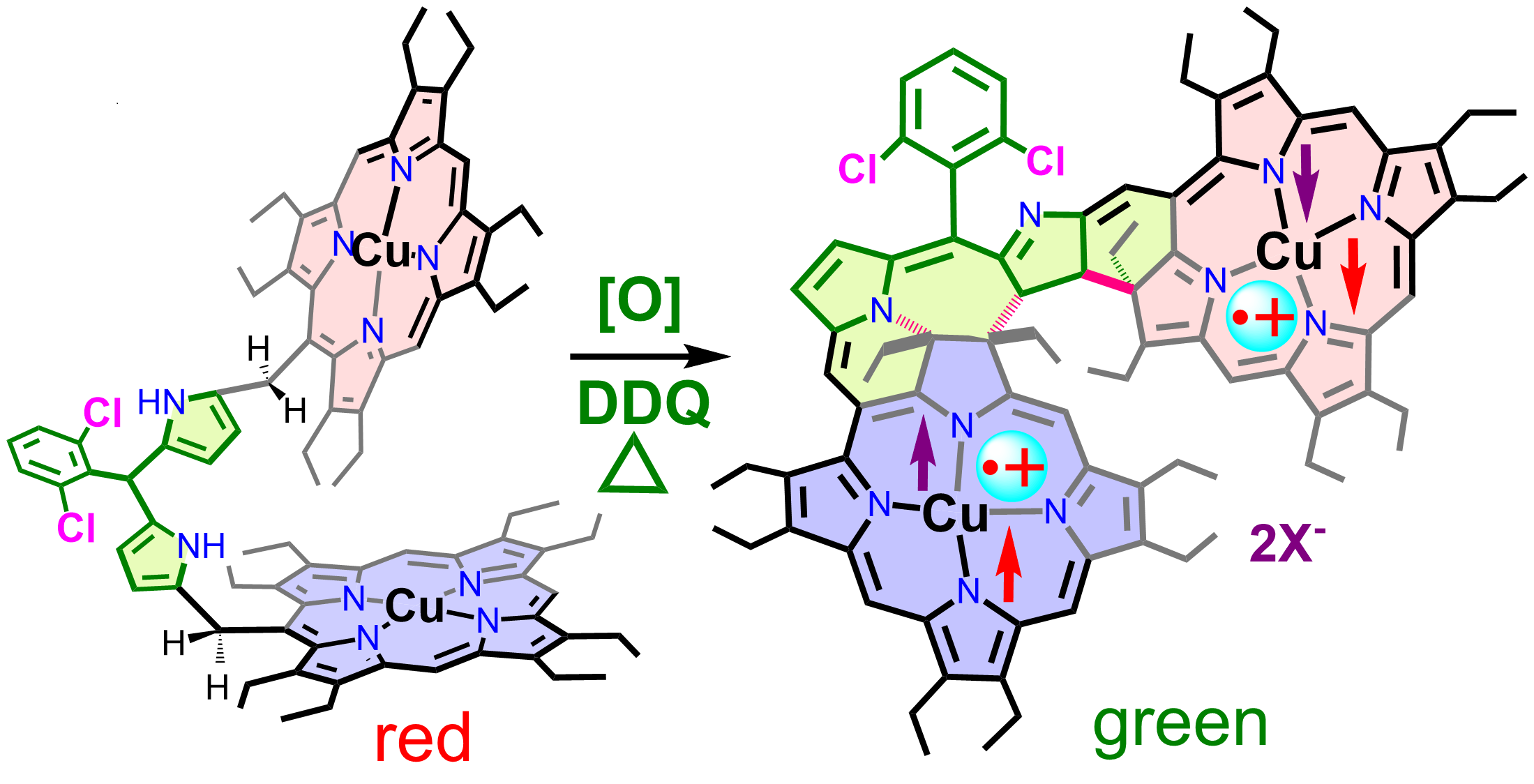
Two highly stable novel triply-fused dinickel(II)/dicopper(II) chlorin-porphyrin dication diradical heterodimers are reported in which the bridge is completely fused between two porphyrin macrocycles. UV-vis, EPR, and ESI-MS investigations enable us to identify some of the key reactive intermediates disclosing tentative mechanistic details of such an unusual transformation.
134. Binuclear Complexes with Single M-F-M Bridge (M: Fe, Mn, and Cu): A Critical Analysis of the Impact of Fluoride for Isoelectronic Hydroxide Substitution
S. Sarkar, F. S. T. Khan, T. Guchhait and S. P. Rath*
Coord. Chem. Rev.
2023, 479, 215003. Full Article
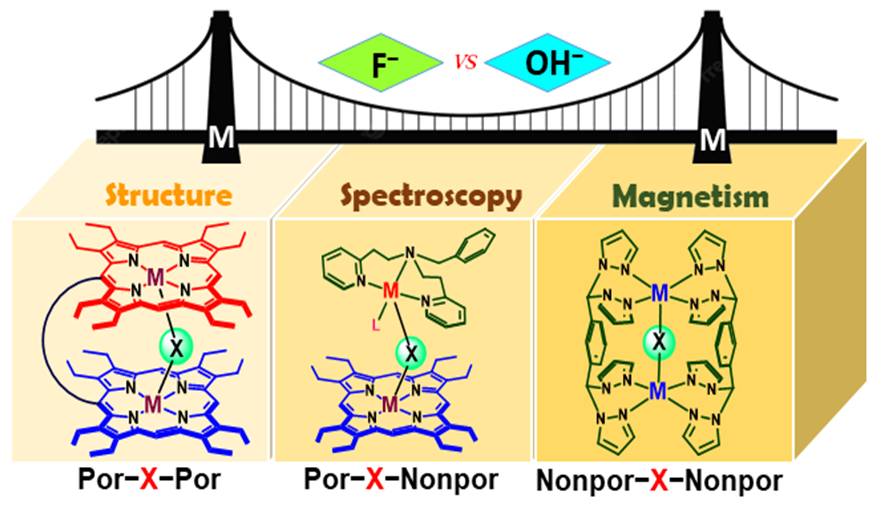
In this review article, we describe an
up-to-date progress of single fluoro-bridged dinuclear metal complexes
and critically scrutinize the impact of fluoride for an isoelectronic
hydroxide substitution. Focus is mainly on understanding the changes in
structural, spectroscopic, and magnetic properties governed solely by the
fluoride bridge as a replacement of hydroxide. Discussion have been
restricted on few magnetically active metal centers, namely Fe, Mn, and Cu,
in which most examples varying only the bridge (F- vs OH-) are reported.
133. Modulation of iron spin states in highly distortediron(III)porphyrin: H-bonding interactions and implications for the hemoproteins
D. Sahoo, R. Mazumdar, S.Pramanik, S. Banerjee, R. Patra and S. P. Rath*
Dalton Trans. 2023, 52, 8904-8917. Full Article (HOT Article)
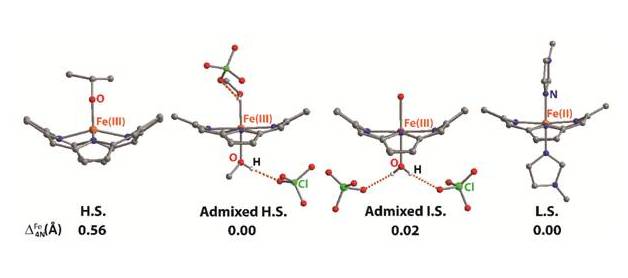
A family of five- and six-coordinated Fe-porphyrins has been reported which enables us to scrutinize the effects of H-bonding interactions on the out-of-plane displacement of iron and their spin-state in the same nonplanar porphyrinic environment.
132. Effect of intermacrocyclic interactions: modulation of metal spin state in oxo/hydroxo/fluoro bridged diiron(III)/dimanganese(III) porphyrin dimers
D. Sil, F. S. T. Khan and S. P. Rath*
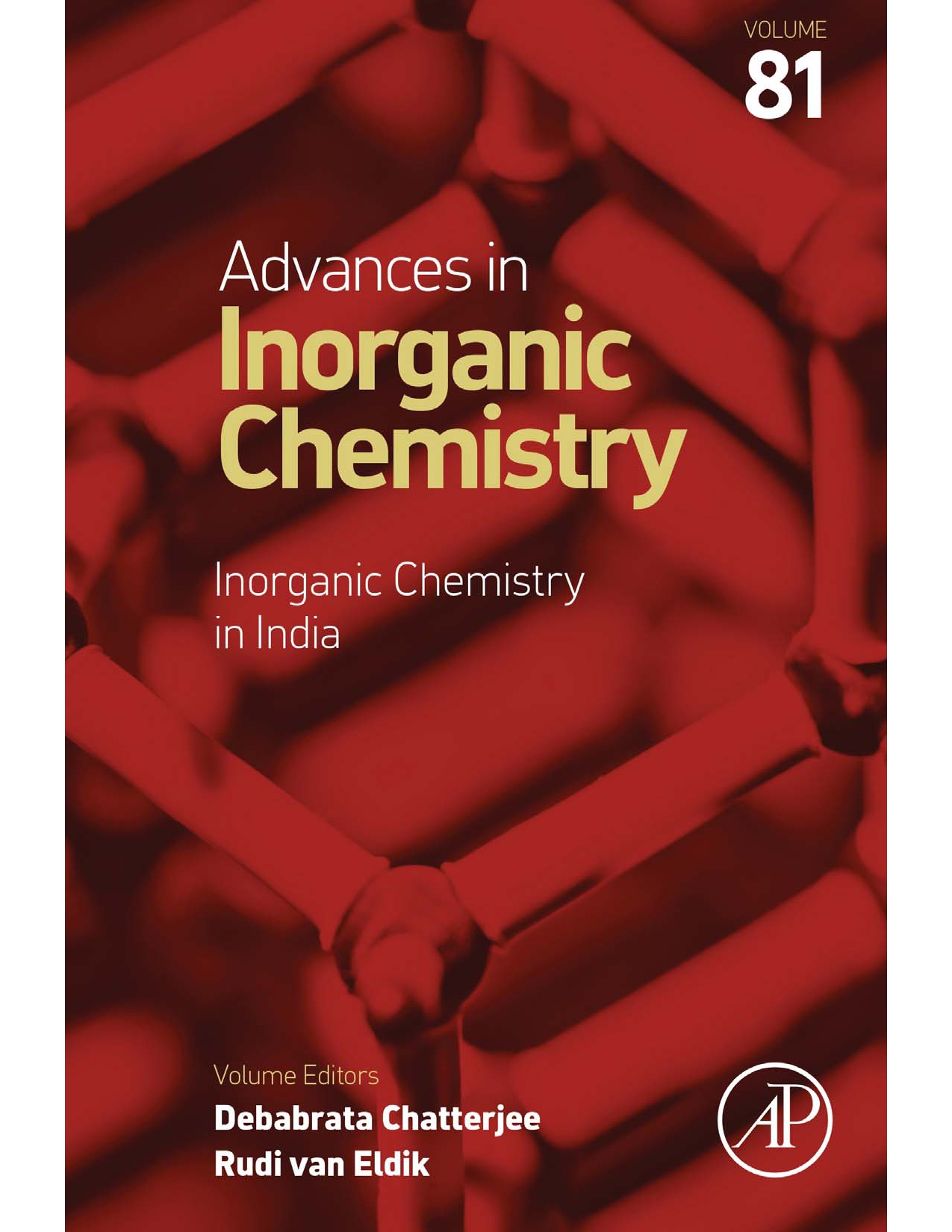
Adv. Inorg. Chem. 2023, 81, 95-184.
Full Article (Invited book chapter to the Special Volume devoted to 'Inorganic Chemistry in India’)131. Diheme Cytochromes: Effect of Mixed-Axial Ligation on the Electronic Structure and Electrochemical Properties with Cobalt Porphyrin Dimer
S. Sanfui, P. Chakraborty, E. Garribba and S. P. Rath*
J. Inorg. Biochem. 2023, 240, 112109 . Full Article (Invited article in the special issue in memory of Prof. F. Ann Walker)
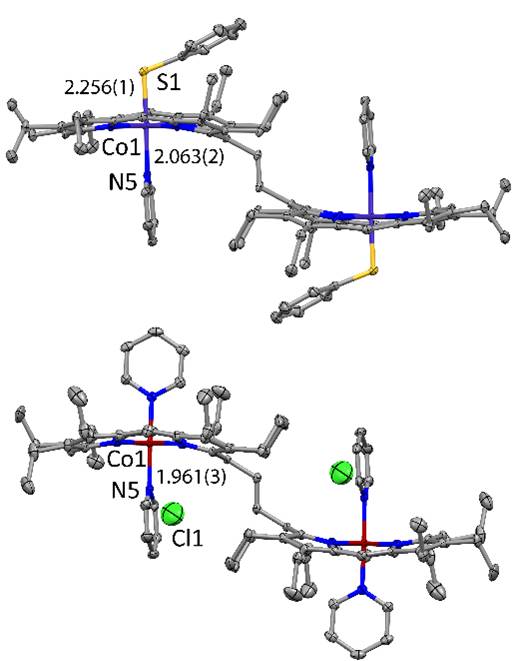
A series of six-coordinate dicobalt(III) porphyrin dimers bearing bis(pyridine) and mixed thiophenolate−pyridine axial ligands are reported as synthetic analogs of diheme cytochromes. The present investigation emphasizes the role of axial ligation, metal ions, and also the effect of intermacrocyclicinteraction in controlling the spectral and electrochemical properties.
130. Control of Spin Coupling Through Redox-active Bridge in Dinickel(II) Porphyrin Dimer: Step-wise Oxidations Enable Isolations of the Chlorin-porphyrin Heterodimer and Dication Diradical with Singlet Ground State
Y. A. Pandit, M. Usman, A. Sarkar, S. J. Shah, and S. P. Rath*
Dalton
Trans. 2023,
52, 877-891.
(Front Cover Page Article)
Full
Article

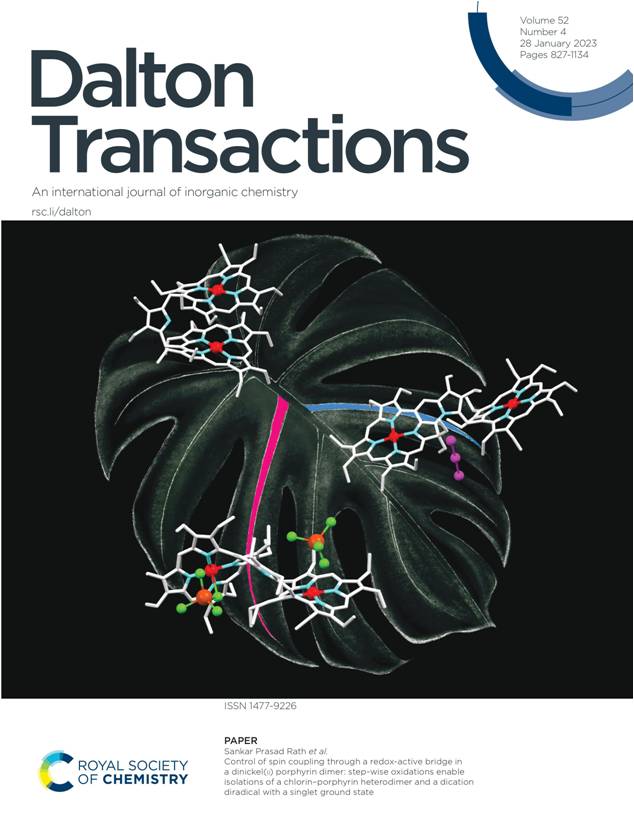
Controlled oxidations of dinickel(II) porphyrin dimer resulted in isolations of two different products: one is the indolizinium-fused chlorin-porphyrin heterodimer and the other one being fully π-conjugated dication diradical species, as shown.
129. Cooperativity in Diiron(III)porphyrin Dication Diradical-Catalyzed Oxa-Diels-Alder Reactions: Spectroscopic and Mechanistic Insights
S. Sarkar, P. Sarkar, D. Samanta, S. K. Pati and S. P. Rath*
ACS Catal. 2022, 12, 9589-9601. Full Article
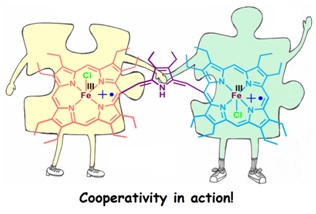
A dication diradical diiron(III) porphyrin dimer was devised as a competent catalyst for the oxa-Diels Alder (ODA) type reaction of aldehydes with 1,3-dienes. The computational studies corroborated the detailed spectroscopic investigation which bespoke of the pivotal roles played by the metal ion as the Lewis acidic centers and also enabled us to delve deeper into the reaction mechanism. The efficacy of employing such a diheme catalyst over mono heme analog is manifested in the cooperative effect which resulted in lower catalyst loading with excellent yields.
128. Induction and Rationalization of Supramolecular Chirality in a Zn(II)porphyrin Dimer using Chiral Substrates: Role of Substrates in the Architectural Selectivity
B. Saha, D. Chandel, C. Pal and S. P. Rath*
J. Porphyrins Phthalocyanines 2022, 27, 350-362. Full Article (Invited article in a special issue dedicated to Prof. Tomas Torres on the occasion of his 70th birthday)

Transfer of chirality has been demonstrated and rationalized in a supramolecular host-guest assembly of a highly flexible Zn(II) porphyrin dimer and chiral diols via sequential formation of a linear 1D polymer followed by 1:2 host-guest monomer. Architectural selectivity for the 1:1 host-guest complexation has been illustrated using a series of achiral and chiral substrates of varying lengths.
127. Induction and Rationalization of Supramolecular Chirality in Highly-Flexible Zn(II)porphyrin Dimer: Structural, Spectroscopic and Theoretical Investigations
D. Chandel, C. Pal, B. Saha, S. A. Ikbal and S. P. Rath*
Dalton Trans. 2022, 51, 14125-14137. Full Article

Transfer and regulation of molecular chirality via 1:1 and 1:2 hostguest complexation has been re-ported using a highly-flexible diethyl-pyrrole bridged Zn(II) porphyrin dimer host with chiral amino alcohols and diols as the substrates.
126. Highly Oxidized Cobalt Porphyrin Dimer: Control of Spin Coupling via Bridge
S. Sanfui, M. Usman, S. Sarkar, S. Pramanik, E. Garribba, and S. P. Rath*
Inorg. Chem. 2022, 61, 8419-8430. Full Article

A series of highly oxidized dicobalt(III) porphyrin dication diradicals are synthesized which, for its stabilization, facilitates the oxidation of the bridge enabling through-bridge communication to generate a fully π-conjugated system. This facilitates the spin coupling between radicals which stabilizes the singlet state.
125. Long-Range Intramolecular Spin Coupling Through-Redox-Active Bridge Upon Stepwise Oxidations: Control and Effect of Metal Ions
Y. A. Pandit, S. J. Shah, M. Usman, S. Sarkar, E. Garribba, and S. P. Rath*
Inorg. Chem. 2022, 61, 5270-5282. Full Article

Dinickel(II) and dicopper(II) porphyrin dimers have been constructed in which two metalloporphyrin units are widely separated by a long unconjugated dipyrrole bridge. Facile oxidation of the bridge generates fully π-conjugated butterfly-like structures, which upon stepwise oxidations by stronger oxidants, result in the formation of the corresponding one and two-electron oxidised species exhibiting long-range electronic communication to produce an intense NIR absorption and triplet state EPR spectra.
124. Hydrogen Bonding Interactions Trigger Induction of Chirality via Formation of a Cyclic Dimer
B. Saha, D. Chandel, and S. P. Rath*
Inorg. Chem. 2022, 61, 2154-2166. Full Article
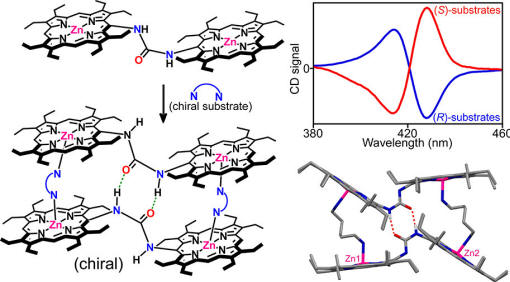
Rationalization for the chirality transfer mechanism in the supramolecular host-guest assemblies of an achiral Zn(II)porphyrin dimer (host) and a series of chiral diamines and diamino esters (substrates) has been reported via formation of 2:2 host–guest cyclic dimer for the first time. Large bisignate CD couplet was observed for the cyclic dimer, whereas the monomeric complexes exhibited negligible CD intensity. Crystallographic characterizations demonstrate strong intermolecular H-bonding in cyclic dimers which is responsible for its stability over the linear chain and thereby display high-intense bisignate CD couplets.
123. Ferromagnetic Coupling in Oxidovanadium(IV)–Porphyrin Radical Dimers
A. K. Singh, M. Usman, S. Sarkar, G. Sciortino, D. Kumar, E. Garribba, and S. P. Rath*
Inorg. Chem. 2021, 60, 16492-16506. Full Article
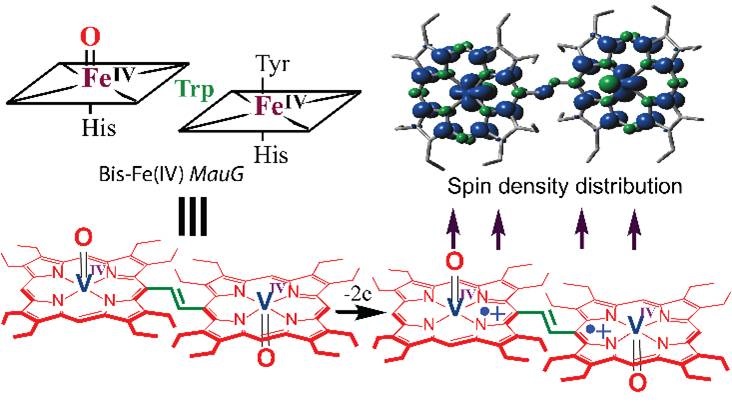
Oxidovanadium(IV) porphyrin dimers have been constructed as synthetic models of highly reactive bis-Fe(IV) intermediate of diheme enzymes such as MauG. Stepwise oxidations upto two oxidizing equivalents provide an unique opportunity to investigate electronic communication and magnetic coupling between unpaired spins either through the bridge or through space. The ferromagnetic coupling occurs between the porphyrin π-cation radical and unpaired electron of VIVO ion on dxy orbital, orthogonal to the porphyrin-based molecular orbitals a1u and a2u.
122. Heme−Heme Interactions in Diheme Cytochromes: Effect of Mixed Axial Ligation on the Electronic Structure and ElectrochemicalProperties
F. S. T. Khan, D. Samanta, D. Chandel, S. J. Shah, and S. P. Rath*
Inorg. Chem. 2021, 60, 12870-12882. Full Article

A schematic diagram overlaying the native diheme cytochromes with the synthetic diheme analog with mixed axial ligation is shown. Present study unmasks the electronic structure and properties of diheme centers and also highlights the significance of their structural arrangement and mixed-axial ligation.
121. Through Bridge Spin Coupling in Homo and Hetero-bimetallic Porphyrin Dimers upon Stepwise Oxidations: A Spectroscopic and Theoretical Investigation
A. Kumar, M. Usman, D. Samanta and S. P. Rath*

Homo- and hetero-bimetallic porphyrin dimers have been synthesized which, upon 2e-oxidation, produce stable dication diradical species as shown. Through the bridge, both porphyrin rings exhibited notable conjugation resulting in effective coupling between metal and porphyrin radical spins of both rings while the coupling model dependent on the nature of metal ion used. Mulliken spin density distributions (as shown, blue: +ve and green: -ve) display the Cu(II) porphyrin center as charge donor while Fe(III)/Mn(III) porphyrin center as charge acceptor.
120. Magnesium Inserted Porphyrin Compound, Its Blends and Devices Thereof
S. S. K. Iyer, S. P. Rath, A. Singh and Sk A. Ikbal
119. Design and control of axial binding with flexible Zn(II) porphyrin dimer: building-up novel polymer with exo–endo binding
D. Chandel, B.Saha, S. A.Ikbal, and S. P. Rath*

Linear exo-endo polymeric chain structures of Zn2DEP with longer bidentate substrates have been reported here. Role of size and nature of the substrates in controlling the design of the axially coordinated complexes has been demonstrated.
118. Fluoro-bridged dimanganese(III) porphyrin dimer: Effect of intermacrocyclic interactions in modulating metal spin state
D. Sil, S.
Banerjee, S. K. Ghosh, and S. P. Rath*

A remarkably bent dimanganese(III)-μ-fluoro porphyrin dimer has been reported here. Unlike its diiron analog, two equivalent high-spin manganese(III) centers with equally distorted porphyrin rings are observed in the complex.
117. Electronic Coupling in Hetero-bimetallic Porphyrin Dimers: A Spectroscopic Investigation
S. Roy, S. Banerjee,
S. Sanfui, and S. P. Rath*
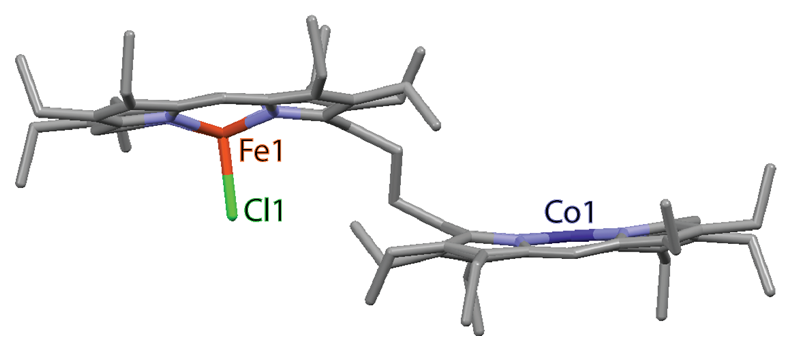
116. Hg···Hg···Hg Interaction Stabilizes Unusual Trinuclear Double Sandwich Structure of Mercury(II) Porphyrins
A. K. Pandey, M. Usman and S. P. Rath*
Inorg. Chem. 2020, 59, 12988–12993.
Full
Article
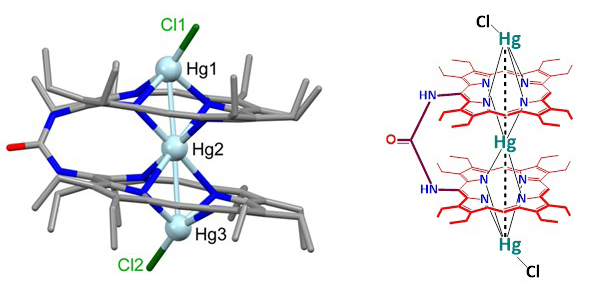
The structure and properties of highly stable trinuclear ‘double sandwich’ complexes of mercury(II) porphyrins having linear Hg3 core with strong mercurophilic interactions are reported here which display highly intense and interesting luminescence properties at room temperature.
115.
Induction, Control and Rationalization of Supramolecular Chirogenesis using Metalloporphyrin tweezers: A Structure-Function Correlation A. Dhamija, P. Mondal, B. Saha, and S. P. Rath*
Dalton Trans. 2020, 49, 10679-10700.
Full
Article
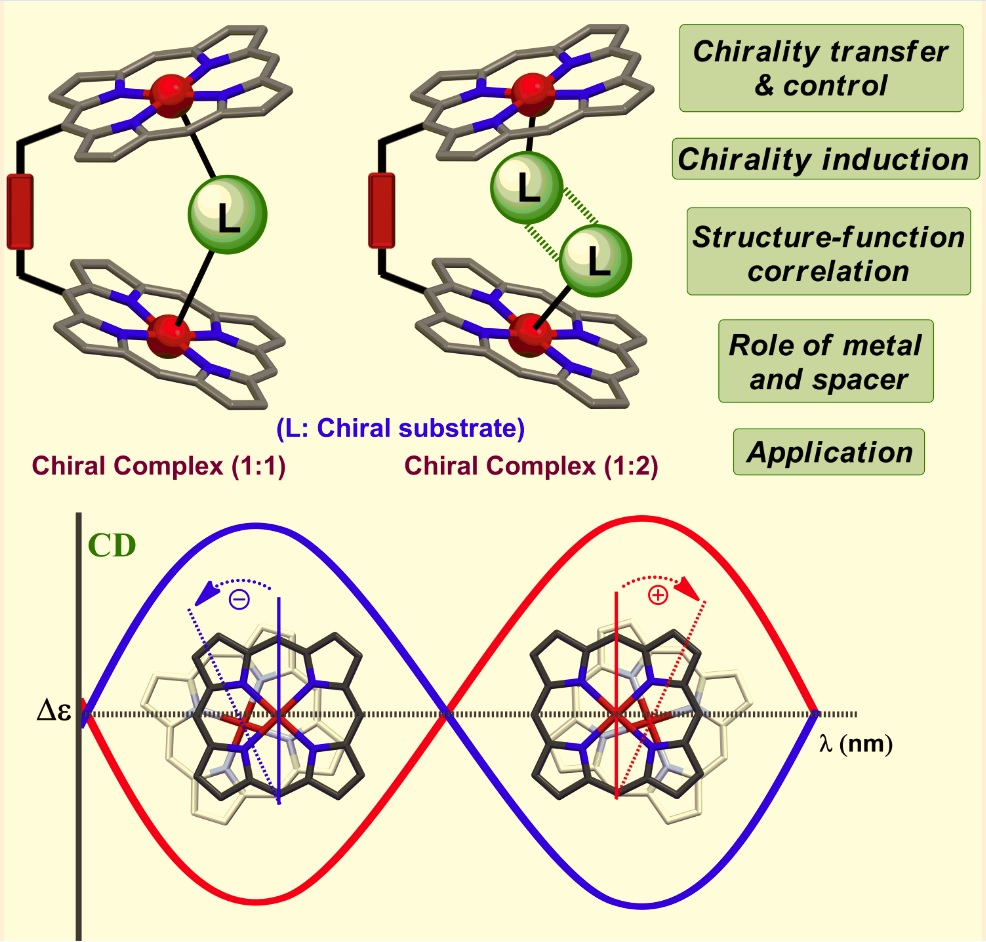
A brief personal account of our systematic investigation for understanding the underpinning mechanism of chirality induction and control at the molecular level over the last few years is presented in this Perspective article.
114. Intermacrocyclic Interaction Upon Stepwise Oxidations in a Monometallic Porphyrin Dimer: Ring versus Metal-centre Oxidations and Effect of Counter Anions
A. K. Singh, and S. P. Rath*
Chem. Eur. J. 2020, 26, 14405 –14418.
Full
Article
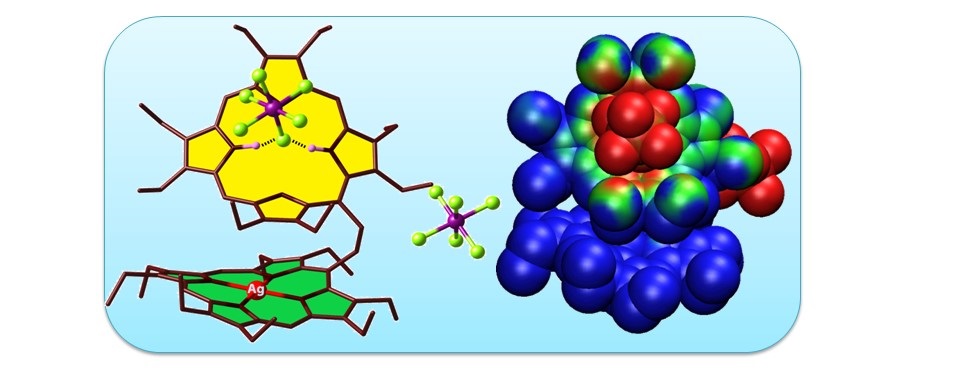
The effect of intermacrocylic interaction was studied by controlled and step-wise oxidations of monometallic silver(II) porphyrin dimer that contains a highly flexible ethane bridge. Step-wise oxidations resulted in the removal of first electron from metal centre while second electron from the metal-free porphyrin ring while their structures vary based on the nature of counter ions.
113.
Stepwise Oxidations in a Cofacial Copper(II) Porphyrin Dimer: Through Space Spin Coupling and Interplay between Metal and Radical spins A. Kumar, S. Sanfui, G. Sciortino, J.-D. Maréchal, E. Garribba, and S. P. Rath*
Detailed investigations are done on the interactions between the two porphyrin macrocycles, between two unpaired spins of closely-spaced Cu(II) centers and between the unpaired spins of metal and porphyrin π-cation radicals.
112.
Complexation of Chiral Zinc(II)Porphyrin Tweezer with Chiral Guests: Control, Discrimination and Rationalization of Supramolecular Chirality B. Saha, S. A. Ikbal, and S. P. Rath*
Chiroptical behaviour of the host-guest complexation have been monitored using chiral zinc(II) bisporphyrin hosts and a large series of chiral guests. Number of stereogenic centers have been varied in both the host and guests for observing the change in the overall helicity of the assembly.
111.
Molecule to Supramolecule: Chirality Induction, Inversion, and Amplification
in a Mg(II)porphyrin Dimer Templated by Chiral Diols
A. Dhamija, B.
Saha, D. Chandel, H. Malik and S. P. Rath*
We report step-wise
chirality induction, amplification and inversion processes occurring via
intermolecular assembling and disassembling between an achiral
Mg(II)porhyrin dimer host and chiral diol as guest just by varying their
stoichiometry.
110. Through
Space Spin Coupling in a Silver(II) Porphyrin Dimer upon Stepwise
Oxidations: AgII/AgII, AgII/AgIII
and AgIII/AgIII Metallophilic Interactions
A. K. Singh, M. Usman,
G. Sciortino, E. Garribba and
S. P. Rath*
Chem. Eur. J.
2019,
25,
10098-10110.
Chem. Eur. J. 2020, 26, 7869 – 7880. Hot
Paper
Full
Article
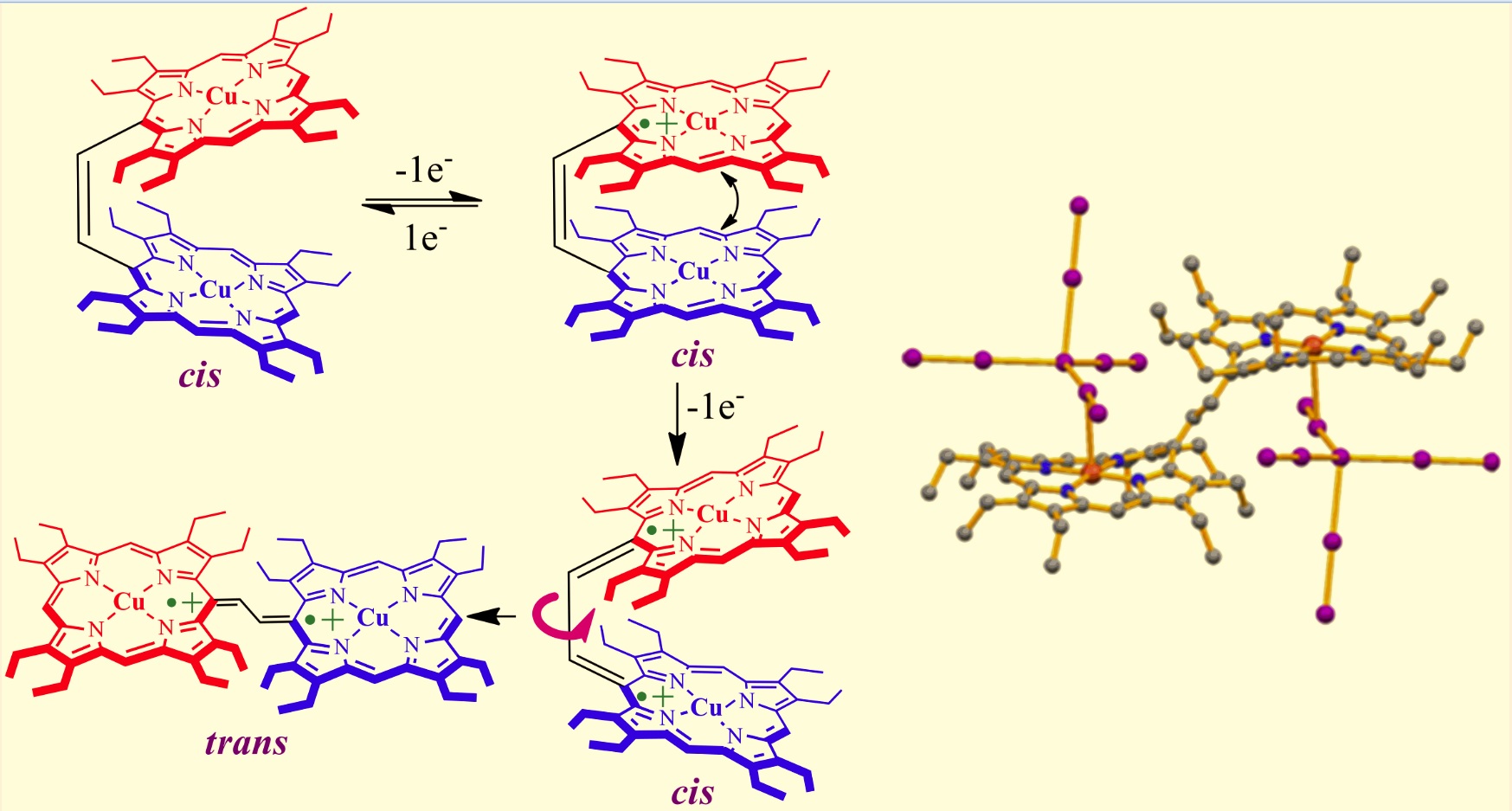
Inorg. Chem.2020, 59, 7795-7809.
Full
Article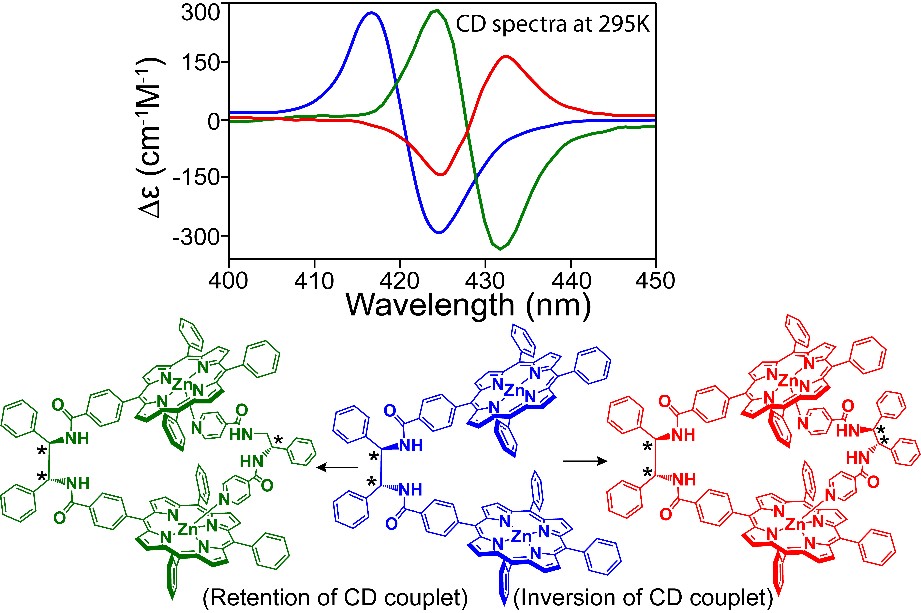
Inorg. Chem. 2020,
59, 801-809.
Full
Article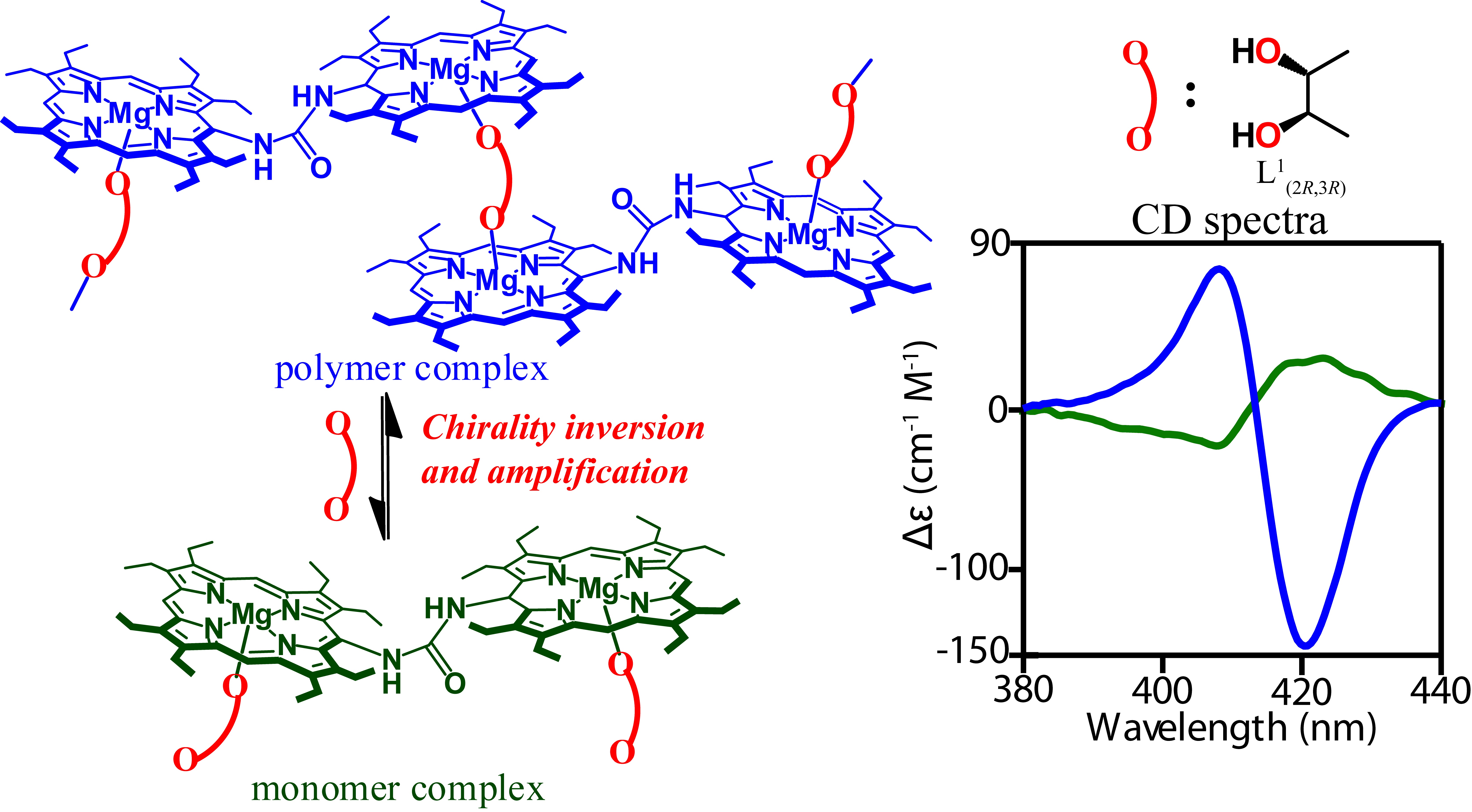
Chem. Eur. J. 2019, 25, 10021-10021. (Cover Picture)
Chem. Eur. J. 2019, 25, 10025-10025. (Cover Profile)

Besides silver(II)•••silver(II) interactions in cis silver(II) porphyrin dimer, stepwise oxidations enable to achieve hitherto unknown silver(II)•••silver(III) and silver(III)•••silver(III) interactions. The strength of such interaction follow the order: AgII/AgII (d9/d9) < AgII/AgIII (d9/d8) < AgIII/AgIII (d8/d8).
109. Cyclic Metalloporphyrin Dimers: Conformational Flexibility, Applications and Future Prospects
P. Mondal and S. P. Rath *
Coord. Chem. Rev. 2020, 405, 213117. Full Article (Invited article in a special issue on “Coordination Chemistry and Catalysis Controlled by Ligand Design”)
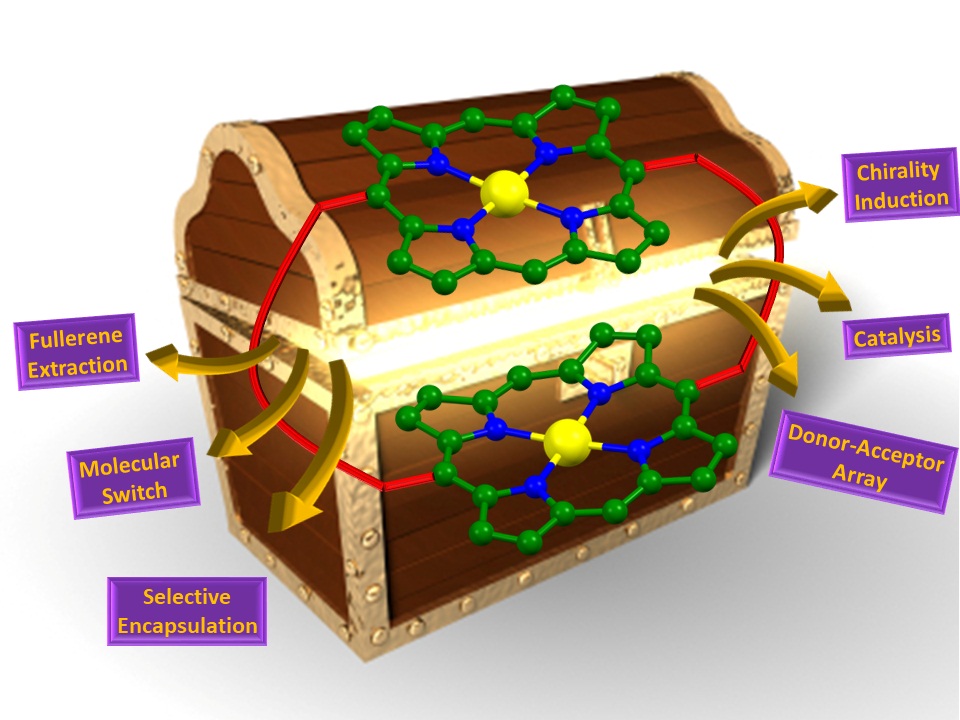
An illustrative spectrum of cyclic metalloporphyrin dimers has been presented here along with their interesting applications.
108. Counter Ion Triggers Stabilization of Two Geometrical Isomers of a Ni(II)dication Diradical Porphyrin Dimer: Role of Anion-π Interactions
A. K. Pandey, M. Usman and S. P. Rath*
Chem. Commun. 2019, 55, 7926-7929. Full Article
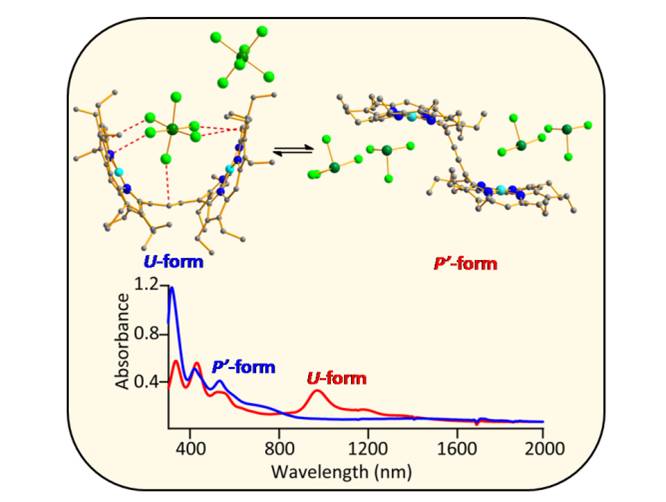
Two geometrical isomers (namely U and P'-forms) of nickel(II) dication diradical porphyrin dimer have been isolated selectively in pure form just by varying oxidant concentrations in the same reaction mixture. Both isomers, stabilized exclusively by anion-π interactions, have unique and very distinct electronic and spectroscopic features and display anion-induced charge/electron transfer phenomenon.
107. A Dimanganese(III) porphyrin dication diradical and its transformation to a μ-hydroxo porphyrin-oxophlorin heterodimer
A. Kumar, D. Sil, M. Usman and S. P. Rath*
Chem. Commun. 2019, 55, 1588-1591. Full Article
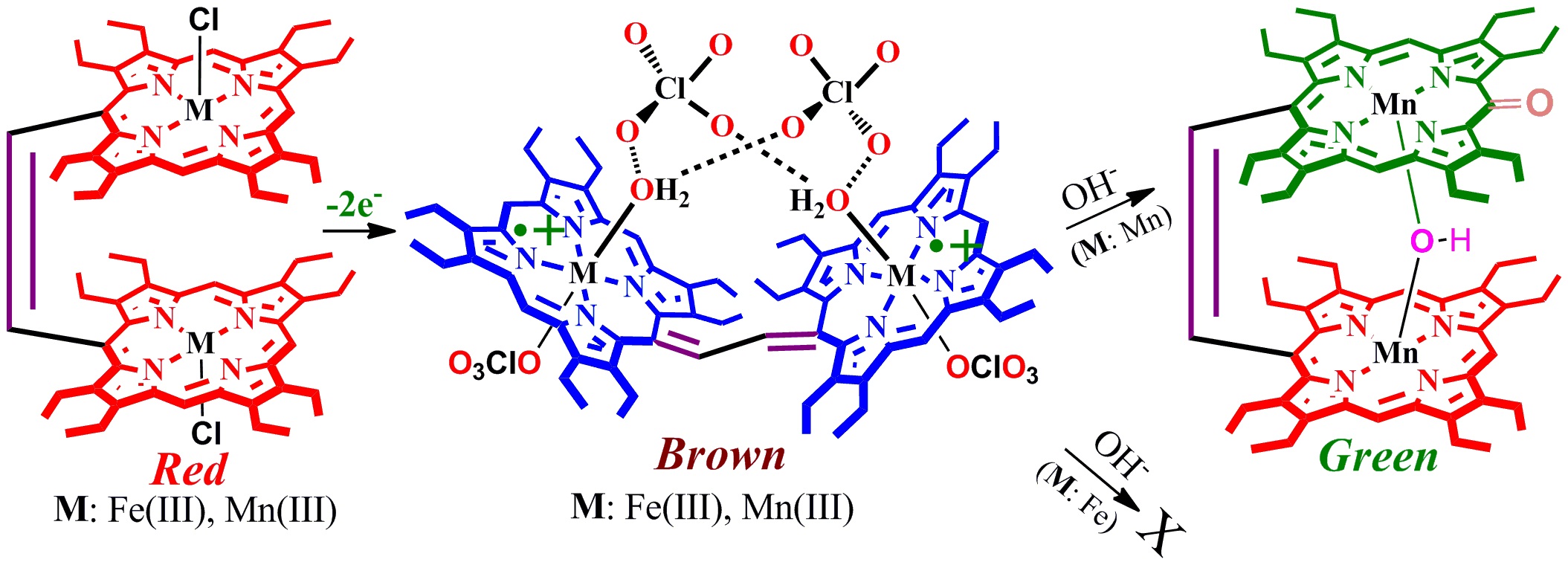
Spin coupling models are different between iron and manganese in their dication diradical complexes which reflected in their reactivity: while addition of tetrabutylammonium hydroxide to dimanganese(III) dication diradical complex quickly converts into the μ-hydroxo dimanganese(III) porphyrin-oxophlorin heterodimer, its dii-iron(III) analog remains very stable.
106. Complexation of Chiral Zinc(II)Porphyrin Tweezer with Achiral Aliphatic Diamines Revisited: Molecular Dynamics, Electronic CD and 1H NMR analysis
B. Saha, A. G. Petrovic, A. Dhamija, N. Berova and S. P.
Rath*
Inorg. Chem. 2019,
58, 11420-11438.
Full
Article

Chiroptical behaviour of the host-guest complexes are reported using (1R,2R)-cyclohexanediamine appended Zn(II) bisporphyrin tweezer host and a series of achiral diamine guest varying the chain lengths. The 1:1 complexation results in inversion of interporphyrin helicity with shorter diamine guests (L2-L5) but retention of helicity of the host with longer diamines (L6-L8).
105. Stepwise Oxidations of Nickel(II)-Iron(III) Heterobimetallic Porphyrin Dimer: Structure, Spectroscopic and Theoretical Investigation
A. Kumar, S. Banerjee, S. Sarkar and S. P. Rath*
Dalton Trans. 2019,
48, 10089-10103.
Full
Article
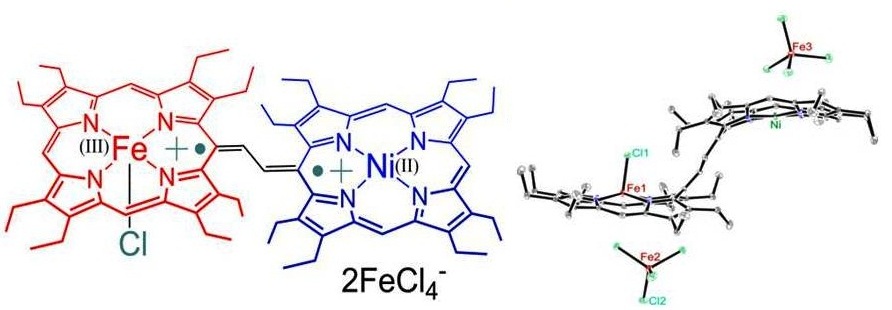
A novel nickel(II)-iron(III) heterobimetallic ethene-bridged porphyrin dimer has been synthesized which upon two-electron oxidation produces nickel(II)-iron(III) dication diradical complex where radicals undergo extensive conjugation through the bridge for all possible interactions.
104. Equatorial ligand plane perturbations lead to a spin-state change in an iron(III)porphyrin dimer
F. S. T. Khan, S. J. Shah, S. Bhowmik, F. G. C. Reinhard, M. A. Sainna, S. P. de Visser* and S. P. Rath*
Dalton Trans. (Communication) 2019, 19, 6353-6357. Full Article

A complete reversal of the spin state of iron(III) is observed upon a small change to the diporphyrin bridge from ethane to ethene by keeping all other factors intact.
103. Controlling the Photophysics of Aromatic Guests Using a Cyclic Porphyrin Dimer: Synthesis, Structure and Encapsulation Mediated “ON-OFF” Switch
P. Mondal, S. Banerjee and S. P. Rath*

A cyclic porphyrin dimer has been employed as a molecular container that can efficiently encapsulate aromatic guests (pyrene/anthracene) inside its cavity. Such entrapment inside the cavity completely alters the photophysics of the encapsulated guests.
102. Axial Ligand Mediated Switchable Rotary Motions in a Ferrocene-bridged Diiron(III) Porphyrin Dimer
A. K. Pandey, S. Sanfui, F. S. T. Khan and S. P. Rath*
J. Organomet. Chem. 2019, 894, 28-38. Full Article (Invited article in a special issue dedicated to Prof. V. Chandrasekhar on the occasion of his 60th birthday)

Ferrocene-bridged diiron(III) porphyrin dimer can switch easily between the syn and anti conformation based on the axial coordination and thereby forming complexes with different structure and properties for the development of synthetic molecular machines.
101. Stabilizing Intermediate-Spin State in Iron(III) Porphyrins
D. Sahoo, S. Roy, F. S. T. Khan, A. K. Singh and S. P. Rath*
Polyhedron 2019, 172, 8-14. Full Article (Invited article in a special issue dedicated to Prof. A. R. Chakravarty on the occasion of his 65th birthday)
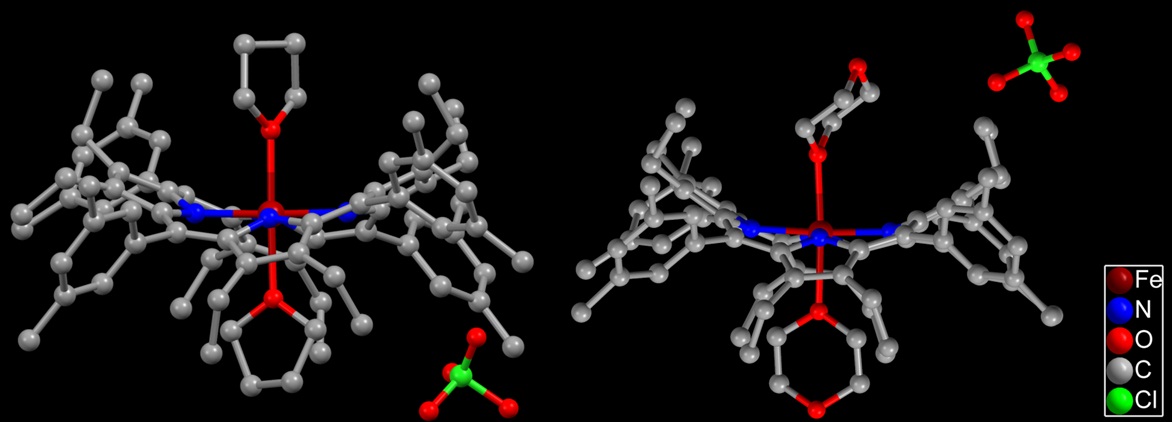
The synthesis, X-ray structure and properties of saddle distorted six-coordinated iron(III) porphyrins having weak axial coordination such as THF and dioxane have been reported which stabilize pure intermediate spin state of iron. The work highlights the possible spin state switching of iron through external perturbations such as H-bonding interactions, weak axial coordination, etc. which are indeed important steps in the functioning of various heme proteins.
100. Ethene-bridged Diiron Porphyrin Dimer as Models of Diheme Cytochrome c: Structure-Function Correlation and Modulation of Heme Redox Potential
F. S. T. Khan, A. Kumar, D. Lai and S. P. Rath*
Inorg. Chim. Acta. 2019, 484, 503-512. Full Article (Invited article in a special issue dedicated to Prof. R. N. Mukherjee on the occasion of his 65th birthday)
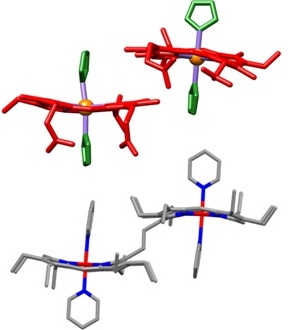
Perspective views of diheme cytochrome c (without protein chain) and its synthetic diheme analog are shown here. The structure−function relationship has been explored using a series of such synthetic dihemes with a variety of imidazoles and pyridines as axial ligands which thereby provide a large structural and functional diversity.
99. Diheme Cytochrome c: Structure-Function Correlation and Effect of Heme-heme Interactions
F. S. T. Khan, S. Banerjee, D. Kumar* and S. P. Rath*
Inorg. Chem. 2018, 57, 11498-11510. Full Article

A schematic diagram overlaying the native diheme cytochrome c (DHC2) with the synthetic diheme analog is shown. Present study unmasks the electronic structure and properties of diheme centers and also highlights the significance of their structural arrangement and axial ligand orientation, and heme-to-heme separation. Long-range attractive dispersion forces between the heme units are evident here.
98. Unusual Stabilization of Dication Diradical Intermediate of Dizinc(II) Porphyrin Dimer
Y. A. Pandit, S. J. Shah and S. P. Rath*
Z. Anorg. Allg. Chem. 2018, 644, 856-863. Full Article (Invited article in a special issue dedicated to Prof. Peter Comba on the occasion of his 65th birthday)

Nature of metal directs the reactivity of a porphyrin π–cation radical. Addition of I2 enables the stabilization of dication diradical porphyrin dimer with zinc(II) but indolizinium-fused chlorin-porphyrin heterodimers with copper(II) and palladium(II).
97. Multiheme Proteins: Effect of Heme-Heme Interactions
D. Lai, F. S. T. Khan, and S. P. Rath*
Dalton Trans. 2018, 47, 14388-14401.
Full Article (Invited Frontier article)(Special Thematic Issue: Molecular metal-containing soft materials)
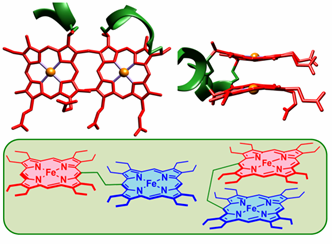
This Frontier illustrates a brief personal account on the effect of heme-heme interaction in dihemes which thereby discloses some of the evolutionary design principles involved in multiheme proteins for its diverse structures and functions.
96. Modulation of Iron Spin in Ethane-bridged Diiron(III) Porphyrin Dimer: Anion Dependent Spin State Switching
F. S. T. Khan, A. K. Pandey and S. P. Rath*
J. Chem. Sci. 2018, 130:85. Full Article (Invited article in a Special Issue on MTIC-XVII)

Anion has been found to induce dramatic change in the structure and properties in the ethane-bridged diiron(III) porphyrin dimer including the spin state of the central metal ion. A brief comprehensive account of such anion-dependent-spin-state change has also been presented here.
95. Silver(III)···Silver(III) Interaction Stabilizes the Syn-form in a Porphyrin Dimer Upon Oxidation
A. K. Singh, F. S. T. Khan and S. P. Rath*
Angew. Chem. Int. Ed. 2017, 56, 8849-8854. Full Article

Meeting at the bridge: Ethane-bridged silver(III) porphyrin dimer exhibits significant metallophilic interaction that brings two porphyrin rings on top of each other with short Ag(III)···Ag(III) distance attributed to the overlap of dz2 metal orbital. The complex displays an intense emission peak at 546 nm at 77 K in the photoluminescence study.
94. Intermacrocyclic Interaction Triggers Facile One-pot Synthesis of a Chlorin-Porphyrin Heterodimer
Y. A. Pandit, S. Sanfui and S. P. Rath*
Chem. Eur. J. 2017, 23, 13415-13422. Full Article

Highly reactive π-cation radicals: Intermacrocyclic interaction stimulates the quantitative one-pot synthesis of a new series of fully π-conjugated unsymmetric chlorin-porphyrin heterodimers by using mild oxidants such as iodine at room temperature.
93. Probing Bis-FeIV MauG: Isolation of Highly Reactive Radical Intermediates
T. Guchhait, S. Sarkar, Y. A. Pandit and S. P. Rath*
Chem. Eur. J. (Communication) 2017, 23, 10270-10275. Full Article
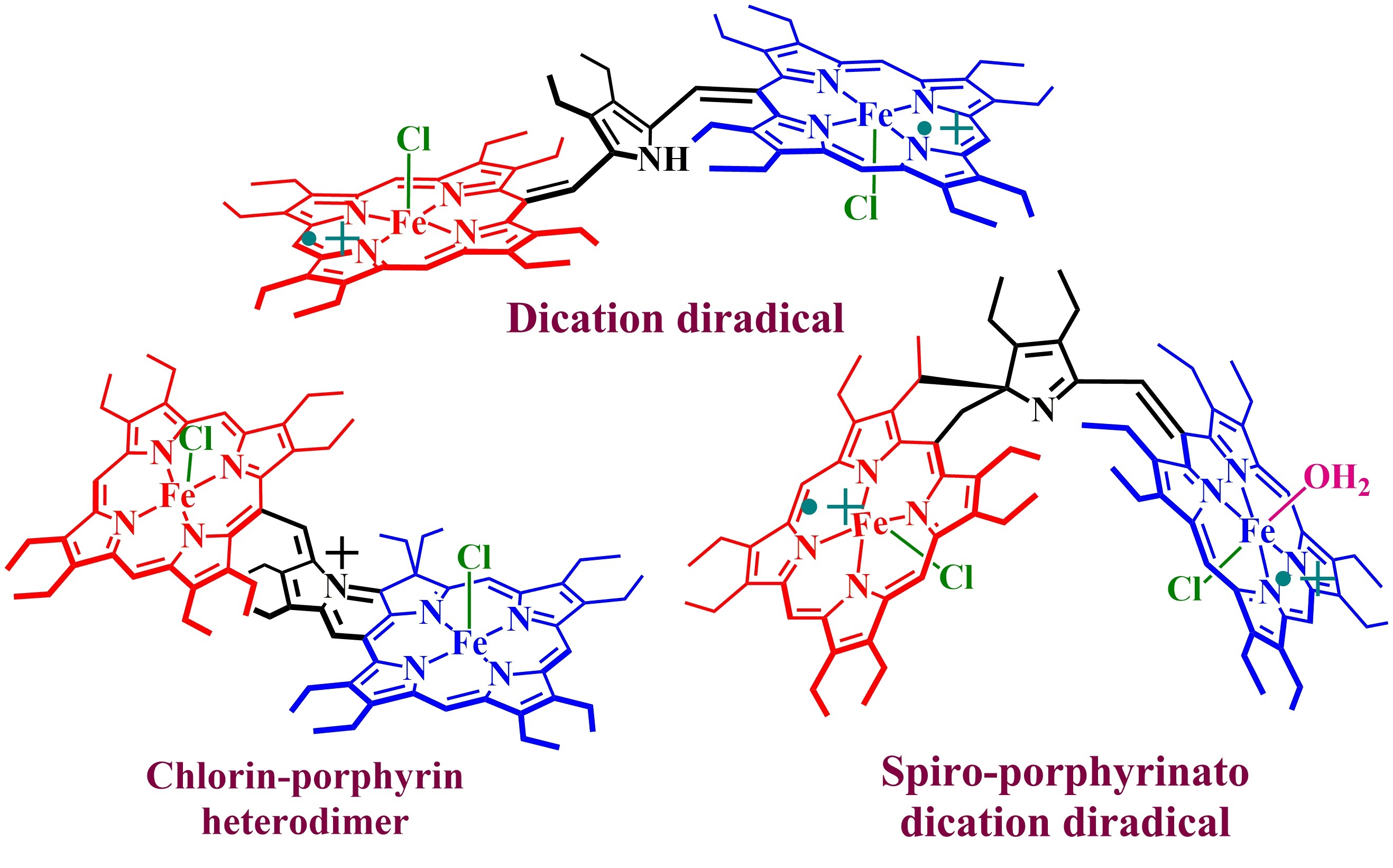
Step-wise oxidations: Step-wise oxidations of a synthetic analog of diheme MauG enable isolation and structural characterizations of dication diradical, indolizinium-fused chlorin-porphyrin heterodimer and spiro-porphyrinato heterodimer. The active role played by the bridge in the electronic communication has been explored.
92. Cyclic Bisporphyrin Based Flexible Molecular Containers: Controlling Guest Arrangements and Supramolecular Catalysis by Tuning Cavity Size
P. Mondal, S. Sarkar and S. P. Rath*
Chem. Eur. J. 2017, 23, 7093-7103. Full Article Highlighted in Synfacts 2017, 13, 816

Accommodating substrates: Three cyclic zinc(II) bisporphyrins (CB) with flexible linkers are employed as artificial molecular containers. Interestingly, the arrangements of the guests and the reactivity inside the containers are significantly influenced by the cavity size.
91. Hydroxo-bridged diiron(III) and dimanganese(III) bisporphyrins: modulation of metal spins by counter anions
F. S. T. Khan, T. Guchhait, S. Sasmal and S. P. Rath *
Dalton Trans. 2017, 46, 1012-1037. Full Article (Invited Perspective and Front Cover Article)
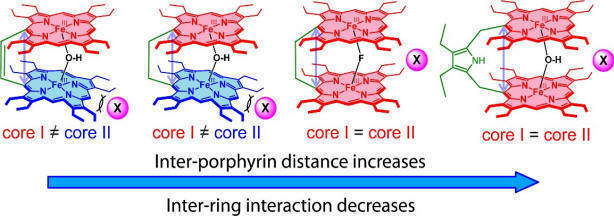
A brief account has been presented on how the inter-heme interactions in μ-hydroxo diiron(III) bisporphyrins and counter anions can induce significant change in the structure and properties including the iron spin state without affecting the overall topology.
90. Oxo- and hydroxo-bridged diiron(III) porphyrin dimers: inorganic and bio-inorganic perspectives and effects of intermacrocyclic interactions
T. Guchhait, S. Sasmal, F. S. T. Khan and S. P. Rath *
Coord. Chem. Rev. 2017, 337, 112-144. Full Article
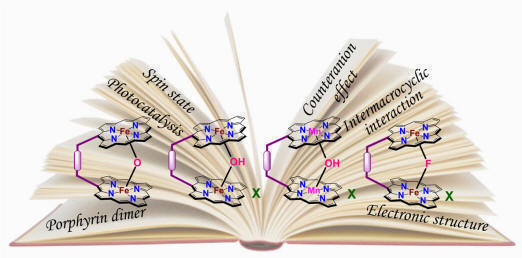
The fascinating chemistry of the oxo and hydroxo-bridged diheme centers, covalently connected through bridges varying in lengths and flexibility, has attracted much attention in recent times and a comprehensive review on their syntheses, structures and spectral properties is presented here.
89. A Tunable Cyclic Container: Guest-Induced Conformational Switching, Efficient Guest Exchange and Selective Isolation of C70 from Fullerene Mixture
P. Mondal and S. P. Rath*
Chem. Asian J. 2017, 12, 1824-1835. Full Article
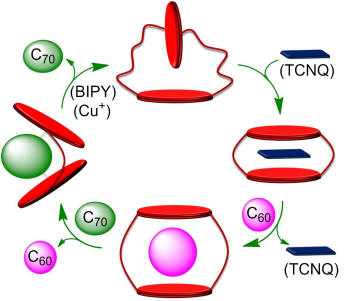
A tunable cyclic porphyrin dimer, 1 has been employed for efficient encapsulation and selective exchange of aromatic guests (TCNQ/C60/C70) by adjusting its conformation. Moreover, a high binding affinity of the cyclic dimer towards C70 over C60 allows easy extraction and efficient isolation of C70 from a C60/C70 fullerene mixture.
88. Metal-Centre-Driven Supramolecular Chirogenesis in Tweezer Amino Alcohol Complexes: Structural, Spectroscopic and Theoretical Investigations
A. Dhamija, B. Saha and S. P. Rath*
Inorg. Chem. 2017, 56, 15203-15215. Full Article
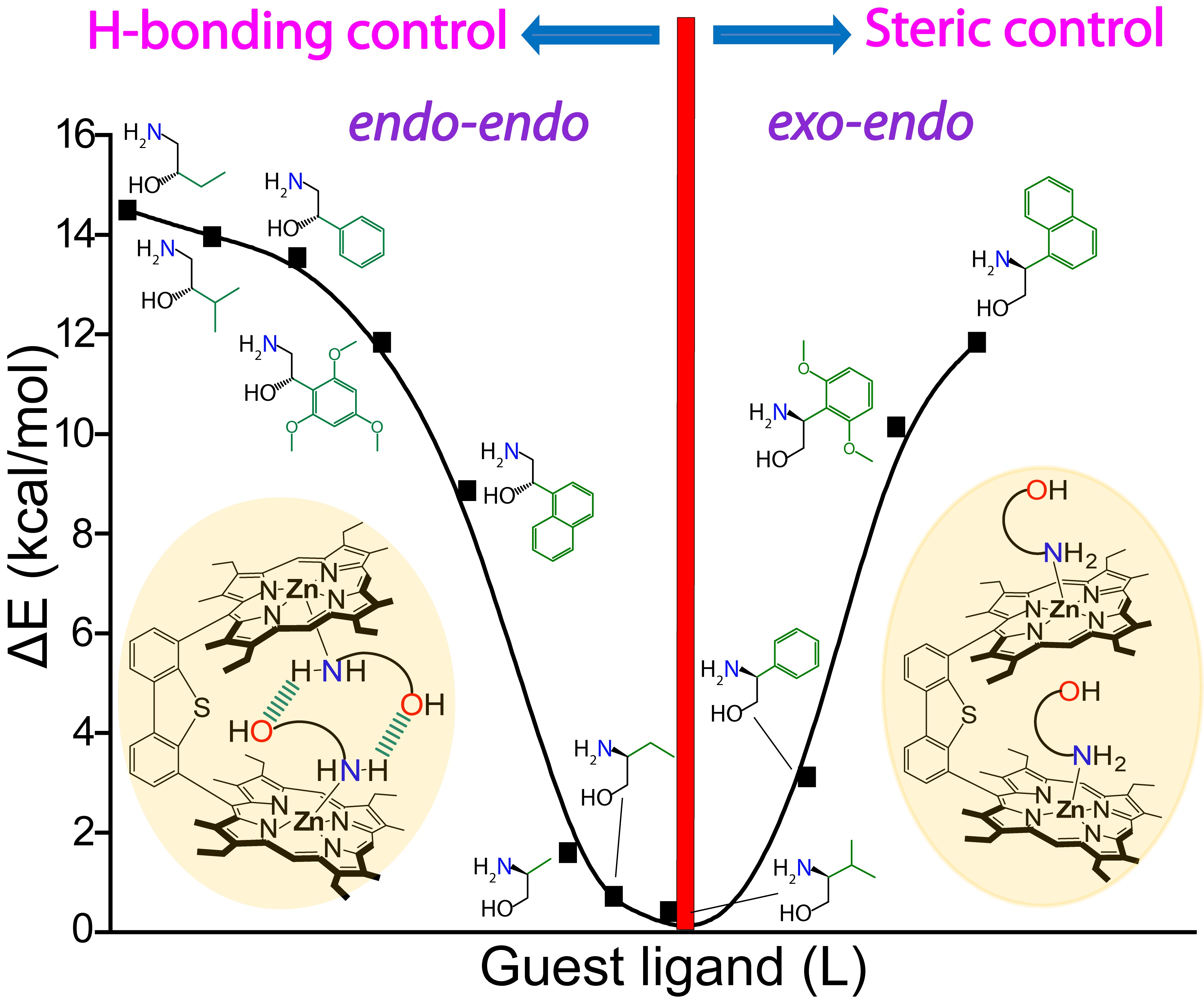
A dibenzothiophene-bridged Zn(II)/Mg(II)bisporphyrin host have been utilized for direct determination of absolute stereochemistry of a series of aminoalcohols. Experimental and DFT calculations have rationalized the role of various geometrical conformers and metal ions therein in the chirality induction processes.
87. Complexation of Chiral Zinc-Porphyrin Tweezer with Achiral Diamines: Induction and Two-Step Inversion of Interporphyrin Helicity Monitored by ECD
B. Saha, Sk. A. Ikbal, A. Petrovic, N. Berova* and S. P. Rath*
Inorg. Chem. 2017, 56, 3849-3860. Full Article
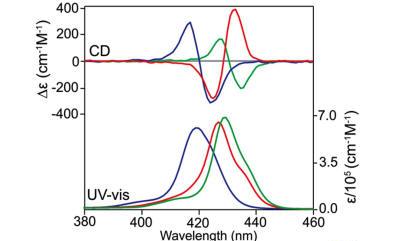
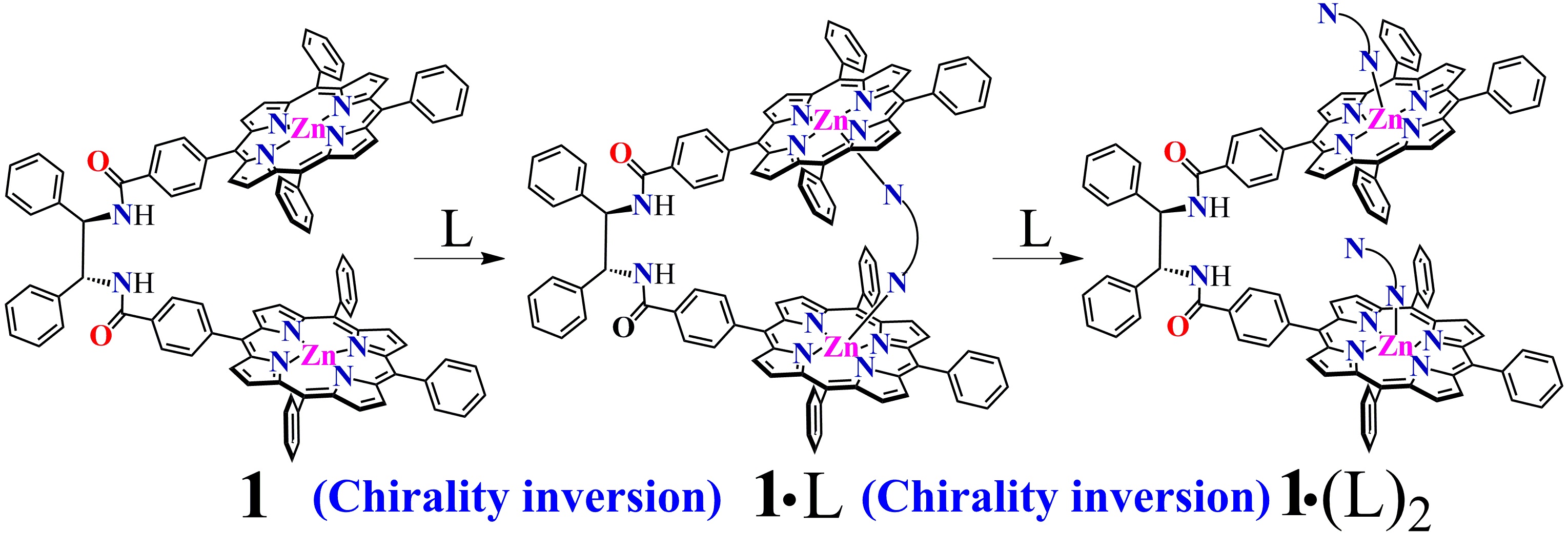
A new chiral Zn(II) bisporphyrin tweezer 1 is synthesized; blue-line shows its CD and UV-vis spectra. Addition of achiral guests such as 1,5-diamino pentane to 1 invert the sign of CD exciton couplet to form 1:1 sandwich complex 1•L (red-line) in its low concentration. Further additions of guest result in second inversion due to the formation of 1:2 open complex 1•(L)2 (green-line).
86. Oxidation Triggers Extensive Conjugation and Unusual Stabilization of Two Di-heme Dication Diradical Intermediates: Role of Bridging Group for Electronic Communication
D. Sil, S. Dey, A. Kumar, S. Bhowmik and S. P. Rath*
Chem. Sci. 2016, 7, 1212-1223. Full Article
(Edge Article)

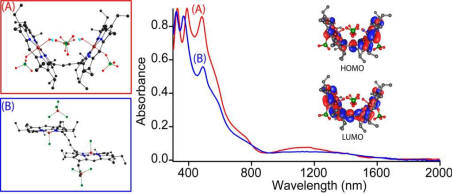
Unlike bis-Fe(IV) state in MauG, the 2e-oxidation has stabilized two ferric hemes, each coupled with a porphyrin cation radical. The extensive π-conjugation enables the generation of a charge resonance band ~1200 nm and allows antiferromagnetic coupling between iron and porphyrin radical spins of both rings.
85. A Highly Oxidized Cobalt Porphyrin Dimer: Spin Coupling and Stabilization of the Four-Electron Oxidation Product
S. Dey, D. Sil and S. P. Rath*
Angew. Chem. Int. Ed. 2016, 55, 996-1000. Full Article
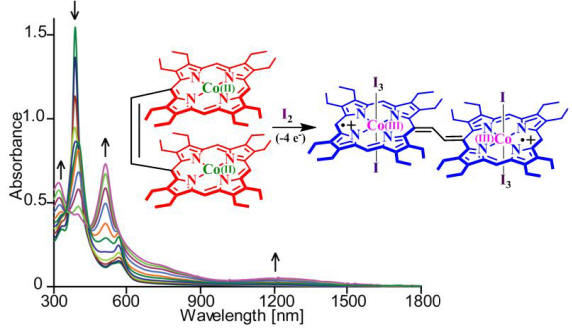
Four to be sure: The oxidation of a cobalt(II) porphyrin dimer with iodine readily produced a cobalt(III) porphyrin π-cation radical dimer. Extensive π conjugation through the ethylene bridge led to several unusual spectral and geometrical features of this four-electron oxidized complex and stabilized the singlet state by enabling strong antiferromagnetic coupling between the π-cation radicals.
84. Hydrogen Bonding Interactions Trigger a Spin-Flip in Iron(III)-Porphyrin Complexes
D. Sahoo, M. G. Quesne, S. P. de Visser* and S. P. Rath*
Angew. Chem. Int. Ed. 2015, 54, 4796-4800. Full Article
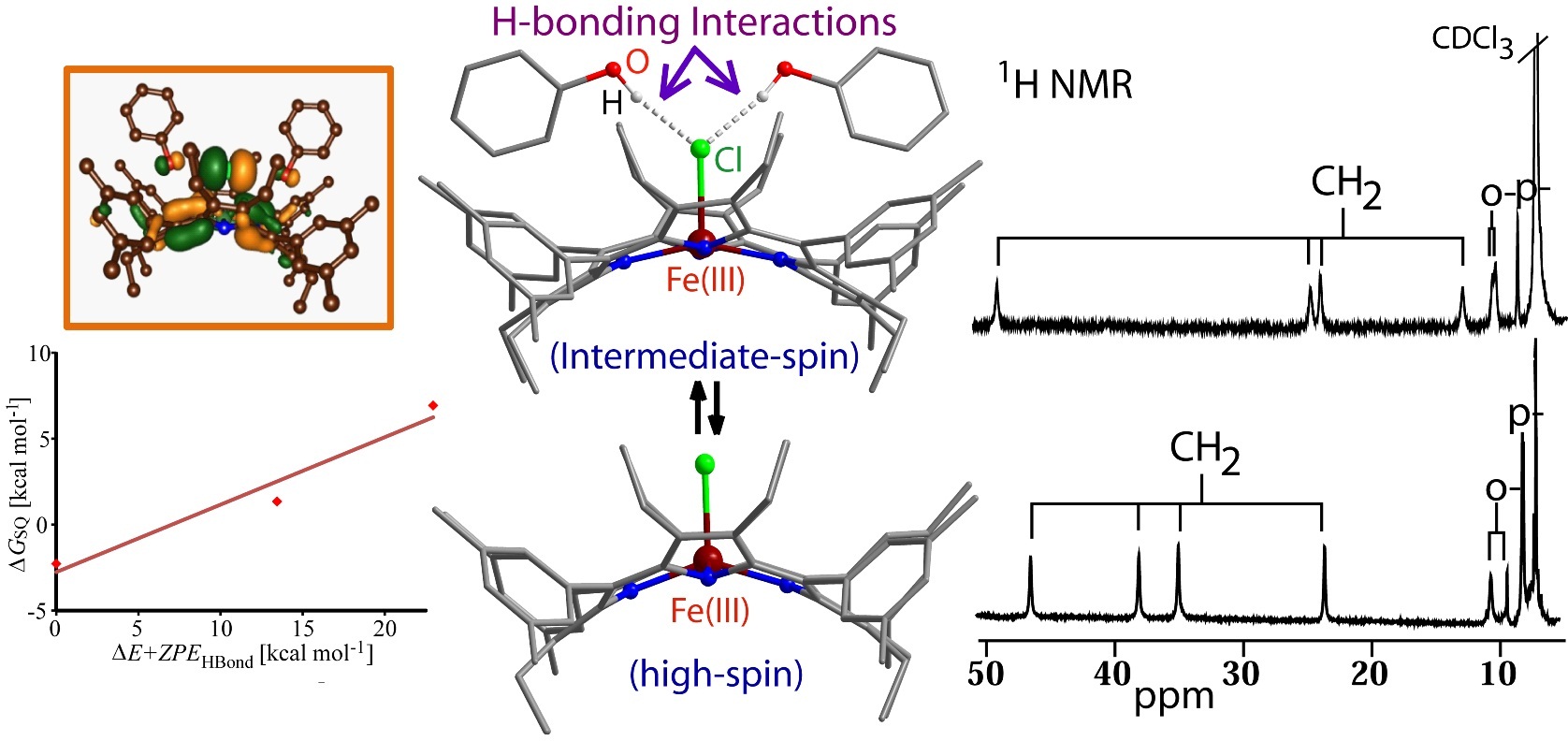
Spin control: The electronic structure of a five-coordinate iron(III) porphinato chloride has been found to depend on the presence of hydrogen-bonding interactions, with the iron center switching reversibly between a high (S=5/2) and intermediate spin (S=3/2) state. Computational calculations clearly support the experimentally assigned spin state.
83. A Nonempirical Approach for Direct Determination of the Absolute Configuration of 1,2-Diols and Amino Alcohols using Mg(II)bisporphyrin
Sk. A. Ikbal, A. Dhamija, S. Brahma and S. P. Rath*J. Org. Chem. 2016, 81, 5440-5449. Full Article
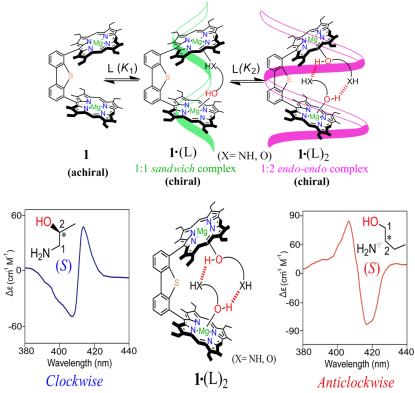
A simple, facile and direct protocol to determine the absolute stereochemistry of a variety of chiral 1,2-diol/amino alcohol at room temperature has been reported. The sign of the CD couplet has also been found inverted on moving the stereogenic centre by one C-atom simply from the bound to an unbound functionality and thus able to discriminate between them.
82. Remarkable Anion Dependent Spin state
Switching in Diiron(III)-μ-Hydroxo Bisporphyrins: What role do Counter ions
play?
F. S. T. Khan, A. K. Pandey and S. P. Rath*
Chem. Eur. J. 2016, 22, 16124-16137. Full Article
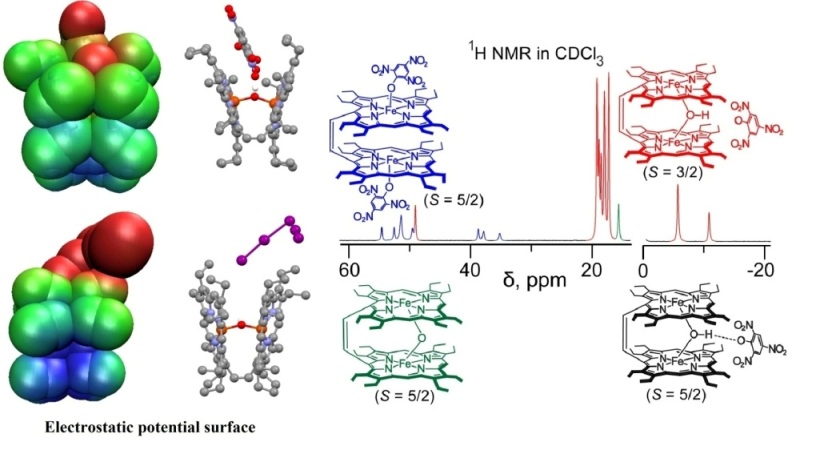
All about the spin: The possible roles of the counter ion in controlling the spin state of iron in μ-hydroxo bisporphyrins are demonstrated. The counter ion has been shown to perturb the spin-state ordering through, for example, hydrogen-bonding interactions, switching between counter ion and axial ligand positions, ion-pair interactions, and charge polarization.
81. Effect of Inter-porphyrin Distance on Spin-state in Diiron(III) μ-Hydroxo Bisporphyrins
D. Sil, F. S. T. Khan and S. P. Rath*
Chem. Eur. J. 2016, 22, 14585-14597. Full Article
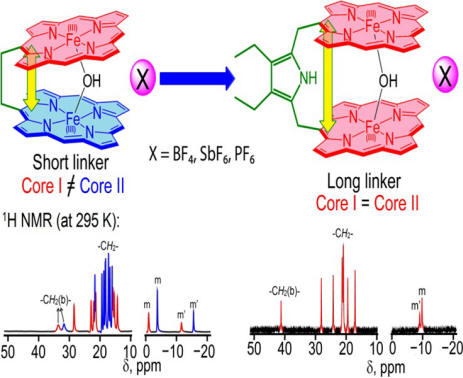
Spot the difference: A series of diethyl pyrrole-bridged diiron(III) μ-hydroxo bisporphyrins that stabilize two equivalent iron(III) centers, unlike previously reported ethane-bridged analogues, are reported. Experimental evidence and DFT calculations indicate the increased inter-porphyrin distance in the diethyl pyrrole-bridged complexes as a factor for rendering the two iron(III) centers equivalent.
80. Diiron(III)-μ-Fluoro Bisporphyrins: Effect of Bridging Ligand on the Metal Spin State
D. Sil, A. Kumar and S. P. Rath*
Chem. Eur. J. 2016, 22, 11214-11223. Full Article [Highlighted as Frontispiece (Hot Paper)]

Metalloporphyrins: A hitherto unknown family of diiron(III)-μ-fluoro bisporphyrins have been synthesized and structurally characterized, for the first time.
79. Cyclic Zn(II)bisporphyrin Based Molecular Switch: Supramolecular Control of Complexation Mediated Conformational Switching and Photoinduced Electron Transfer
P. Mondal and S. P. Rath*
Chem. Eur. J. 2016, 22, 5607-5619. Full Article
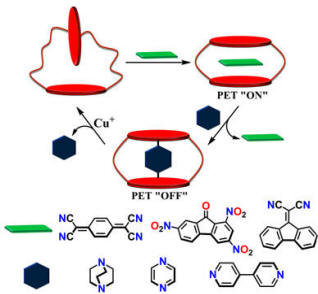
Molecular switch: A cyclic zinc(II) bisporphyrin was employed as an efficient molecular switch under the regulation of π-acceptors and bidentate guests, which ultimately control the molecular orientation and charge-transfer process. During the process, two porphyrin rings also reversibly change their relative orientation between perpendicular and parallel.
78. Induction and Rationalization of Supramolecular Chirality in the Tweezer-diamine Complexes: Insights from Experimental and DFT Studies
A. Dhamija, Sk. A. Ikbal and S. P. Rath*
Inorg. Chem. 2016, 55, 13014-13026. Full Article
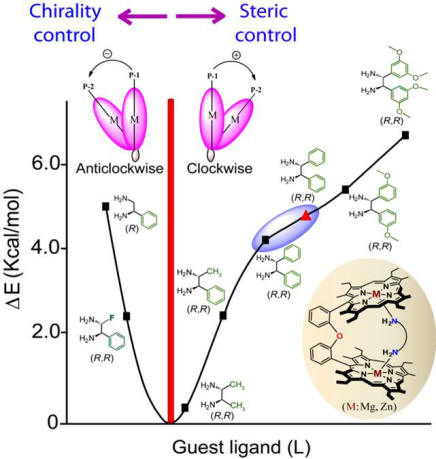
A series of supramolecular chiral 1:1 sandwich complexes consisting of diphenylether/ethane bridged metallo-bisporphyrin host and chiral diamine guest (L) have been reported. Experimental and DFT calculations have demonstrated the possible interconversion between clockwise (steric-controlled) and anticlockwise (chirality-controlled) twisted conformers just upon changing the bulk of the substituent irrespective of the nature of chirality at the stereogenic centre.
77. Experimental and Theoretical Investigation on a Series of Novel Dimanganese(III)-μ-hydroxo Bisporphyrins: Magneto-Structural Correlation and Effect of Metal Spin on Porphyrin Core Deformation
D. Sil, S. Bhowmik, F. S. T. Khan and S. P. Rath*
Inorg. Chem. 2016, 55, 3239-3251. Full Article

A hitherto unknown family of remarkably bent dimanganese(III)-μ-hydroxo bisporphyrin with different counter anions have been reported here. Unlike its diiron analog, two equivalent high-spin manganese(III) centers with equally distorted porphyrin rings are observed in the complexes.
76. Effect of Two Interacting Rings in Metalloporphyrin Dimers upon Stepwise Oxidation
S. Dey, D. Sil, Y. A. Pandit and S. P. Rath*
Inorg. Chem. 2016, 55, 3229-3238. Full Article
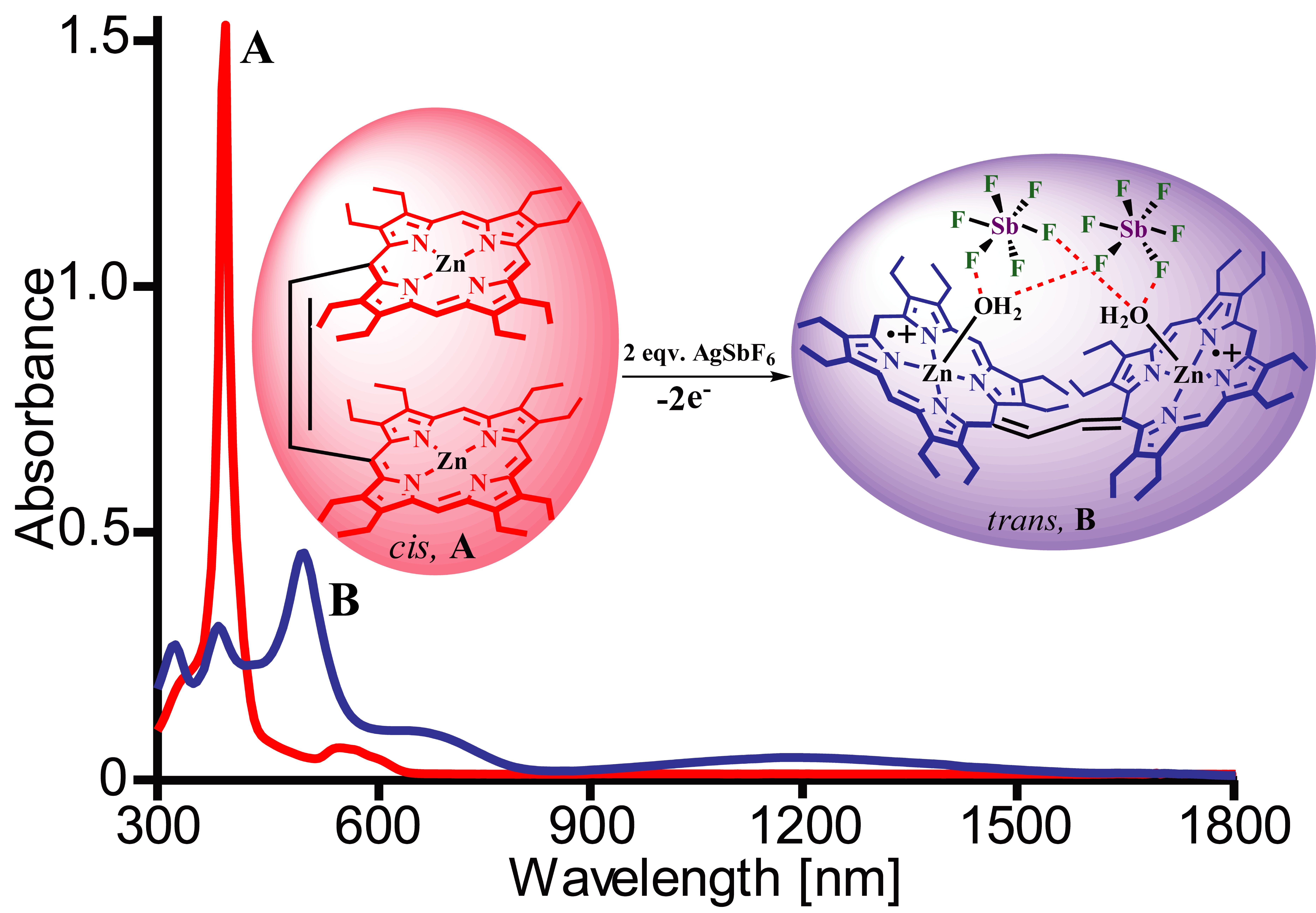
2e-oxidation of ethylene-bridged metalloporphyrin dimers (M: 2H, Zn2+) result in the formation of dication diradical complexes in which the cis isomer converts to trans. Structural and spectroscopic investigations have revealed strong electronic communications between two porphyrin π-cation radicals through the bridge which also allows strong antiferromagnetic coupling between the radical spins to form diamagnetic complexes.
75. Binuclear Highly distorted Iron(III) Porphyrins Bridged by the Dianions of Hydroquinones: Role of Bridge in the Electronic Communication
D. Sahoo, A. K. Singh and S. P. Rath*
Eur. J. Inorg. Chem. 2016, 3305–3313. Full Article
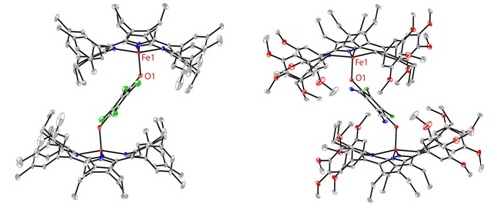

A family of binuclear highly substituted and distorted ferric porphyrins bridged through a variety of p-hydroquinone dianions is reported. The iron centres are involved in weak antiferromagnetic exchange interactions, the extent of which depends on the electronic nature of the bridge.
74. Spin Modulation in Highly Distorted Fe(III) Porphyrinates Using Axial Coordination and their π-Cation Radicals
D. Sahoo, T. Guchhait and S. P. Rath*
Eur. J. Inorg. Chem. 2016, 3441–3453. Full Article
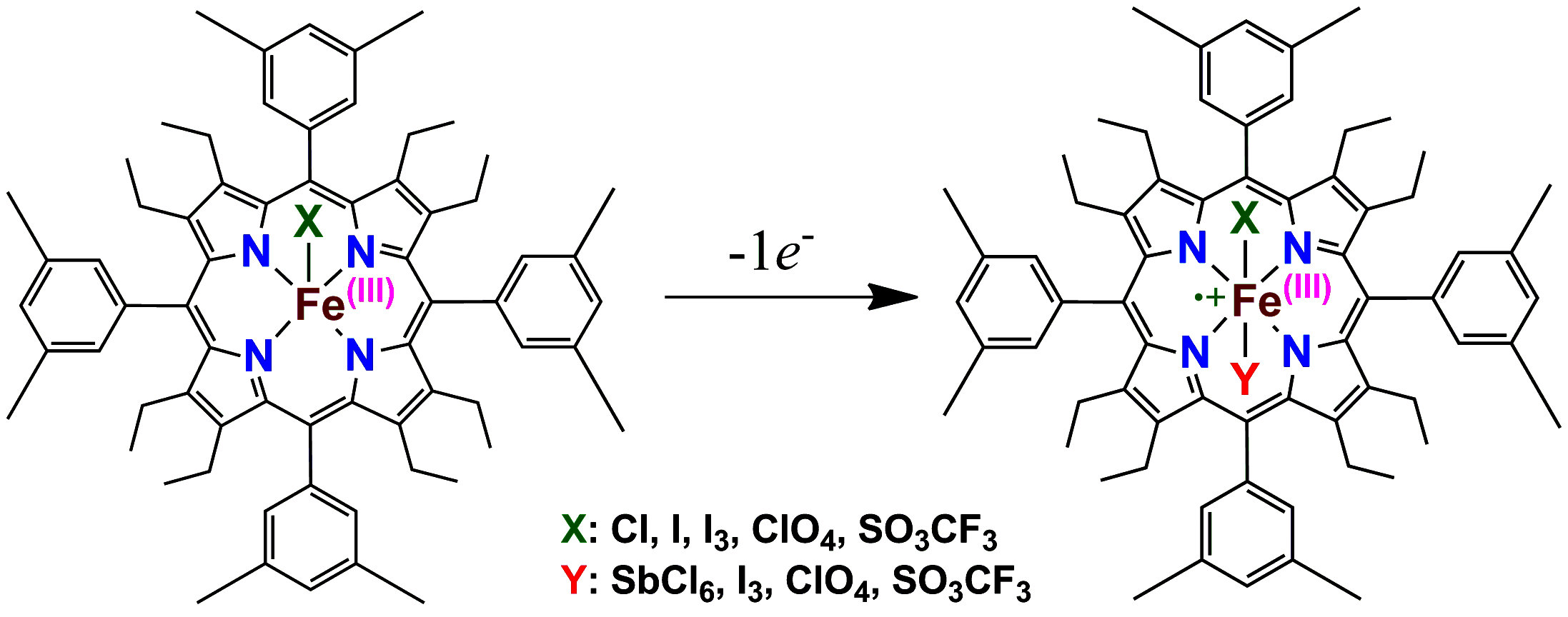
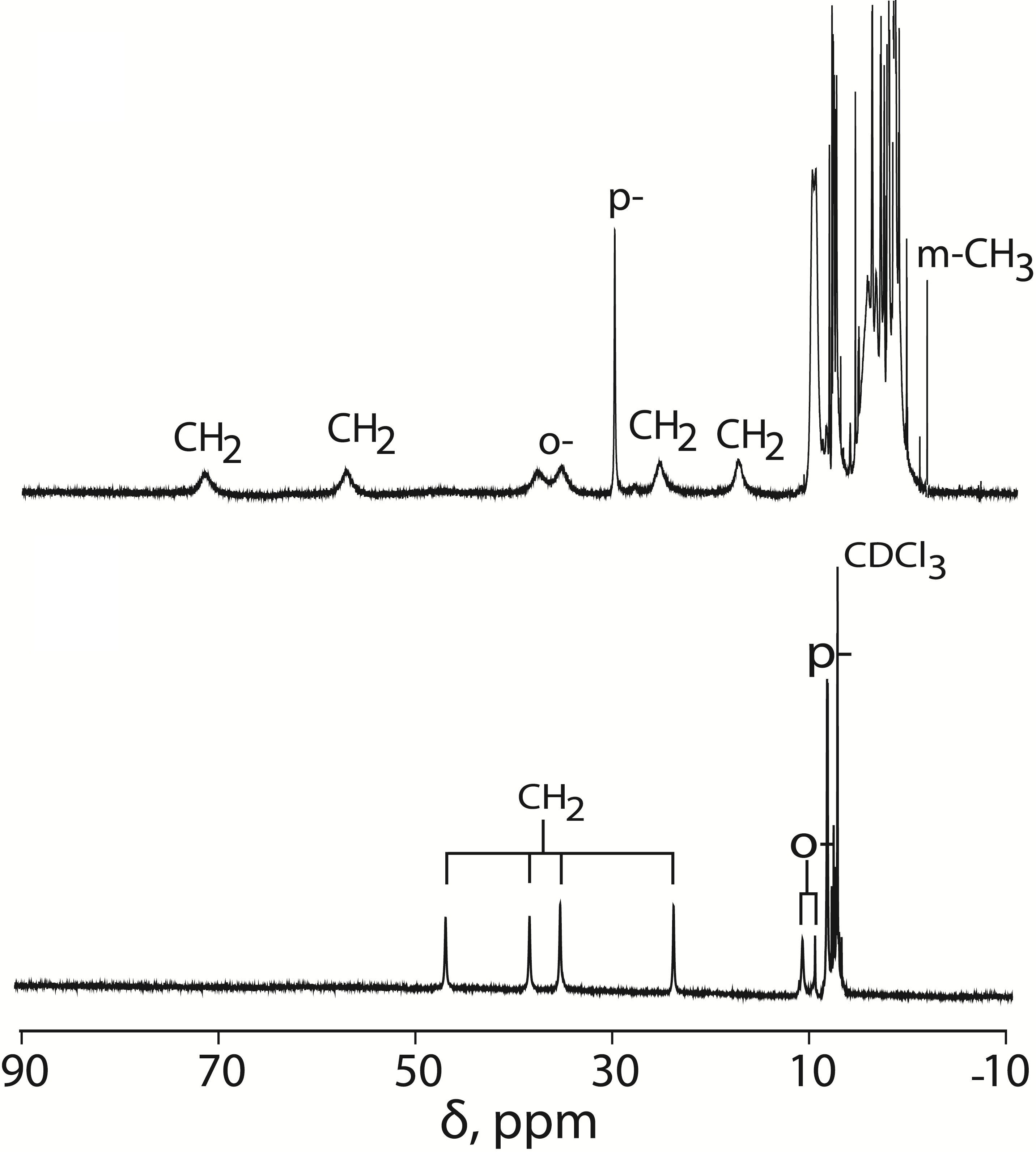
A series of five-coordinate Fe(III)octaaryltetraphenylporphyrins varying axial ligand field strength and their 1e-oxidized complex have been synthesized and characterized. The molecular structures and their spectroscopic properties including metal spins have been scrutinized.
73. An Ethane-bridged Porphyrin Dimer as Model of Di-heme Proteins: Inorganic and Bioinorganic Perspectives and Consequences of Heme-Heme Interactions
D. Sil and S. P. Rath*
Dalton Trans. 2015, 44, 16195-16211. Full Article (Invited Perspective Article)
A brief account of our recent efforts on how inter-heme interactions can possibly change the structure and functional properties of the individual heme centers in a highly flexible ethane-bridged porphyrin dimer has been presented.
72. Controlled generation of highly saddled (porphyrinato) iron(III) iodide, tri-iodide and one-electron oxidized complex
D. Sahoo and S. P. Rath*
Chem. Commun. 2015, 51, 16790-16793. Full Article

Three iron(III) porphyrinato complexes have been isolated selectively just by varying iodine concentration which eventually form admixed-intermediate (iodo complex), pure intermediate (tri-iodide complex) and high-spin (1e-oxidized complex) states of iron where iodide and/or tri-iodide used as axial ligands. Computational calculations clearly support the experimentally assigned spin state.
71. Metal-coordination-driven Mixed Ligand Binding in Supramolecular Bisporphyrin Tweezers
Sk. A. Ikbal, A. Dhamija and S. P. Rath*
Chem. Commun. 2015, 51, 14107-14110. Full Article
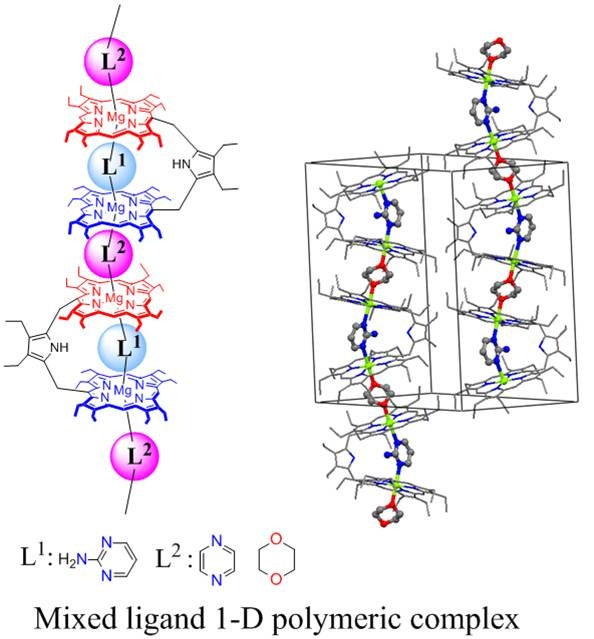
The mixed ligand polymers of Mg(II)bisporphyrin with heterogeneous guest pairs have been synthesized just by mixing host and guests in one pot and structurally characterized. The guest ligands are bound selectively between inside and outside the bisporphyrin cavity.
70. Step-wise induction, amplification and inversion of molecular chirality through the coordination of chiral diamines with Zn(II)bisporphyrin
Sk. A. Ikbal, S. Brahma and S. P. Rath*
Chem. Commun. 2015, 51, 895-898. Full Article

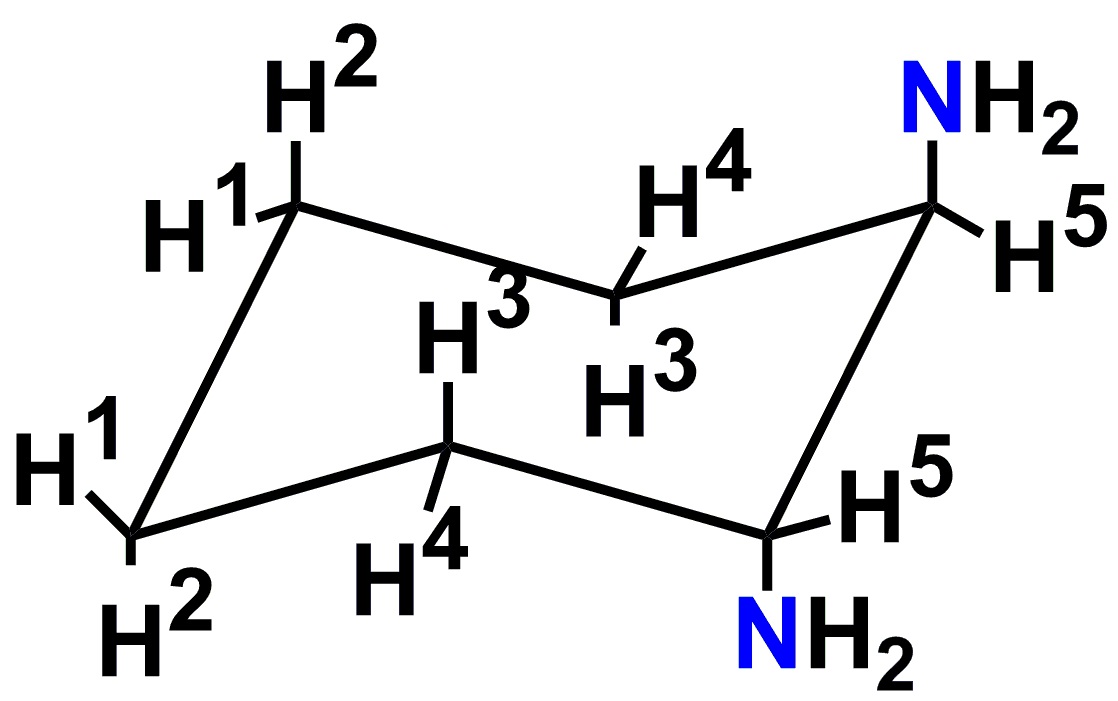
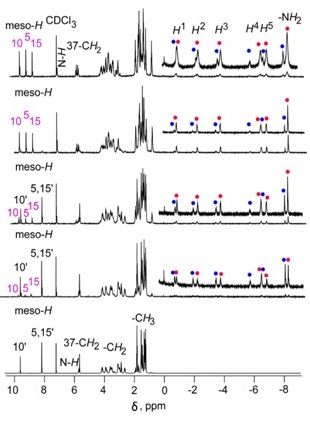
A clear structural rationalization of the origin of chirality transfer from an optically active diamine guest to an achiral Zn(II)bisporphyrin host in a 1:1 and 2:3 host-guest supramolecular complex has been demonstrated for the first time. During the process, chirality inversion along with amplification was observed.
69. Stoichiometry-controlled supramolecular chirality induction in magnesium (II) porphyrin dimer by amino alcohols: mechanistic insights and effect of ligand bulkiness
S. A. Ikbal, B. Saha and S. P. Rath*
J. Indian Chem. Soc. 2015, 92, 2001-2014. (Invited article in a special issue of the Journal of Indian Chemical Society on the occasion of 80th birthday of Prof. Animesh Chakravorty)
68. Highly selective and sensitive detection of picric acid explosive by a bisporphyrin cleft: synergistic effects of encapsulation, efficient electron transfer, and hydrogen bonding
P. Mondal and S. P. Rath*
Eur. J. Inorg. Chem. 2015, 4956-4964. Full Article

An efficient host–guest complexation leads to rapid, highly selective, and efficient detection of picric acid (PA) in the presence of other nitroaromatics in solution as well as in the solid phase.
67. Spin state ordering in hydroxo bridged diiron(III)bisporphyrin complexes
M. A. Sainna, D. Sil, D. Sahoo, B. Martin, S. P. Rath,* P. Comba* and S. P. de Visser*
Inorg. Chem. 2015, 54, 1919-1930. Full Article
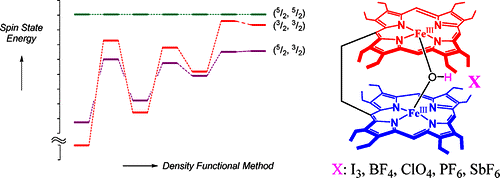
We report the synthesis, structure, and spectroscopic characterization of 1,2-bis[μ-hydroxo iron(III) 5-(2,3,7,8,12,13,17,18-octaethylporphyrinyl)]ethane with PF6– and SbF6– counteranions. The two iron centers are nonequivalent with admixed intermediate spin state (S = 3/2 with a minor contribution of S = 5/2) on each metal both in the solid and in solution. The molecules are compared with previously known μ-hydroxo complexes with other counterions, such as I3–, BF4–, and ClO4–, which demonstrates that the nature of the counterion can affect the spin-state ordering dramatically.
66. Aggregation-controlled excimer emission in an axial anthracene–Sn(IV)porphyrin–anthracene triad in the solid and solution phases
S. Dey, P. Mondal and S. P. Rath*
New J. Chem. 2015, 39, 4100-4108. Full Article (Invited article)

An anthracene-porphyrin donor-acceptor triad has been synthesized and its photophysical properties along with excimer behavior are investigated.
65. Efficient Host-Guest Complexation of a Bisporphyrin Host with Electron Deficient Guests: Synthesis, Structure and Photoinduced Electron Transfer
P. Mondal and S. P. Rath*
Isr. J. Chem. 2016, 56, 144-155. Full Article (Invited article in a special issue on "Porphyrins and Porphyrinoids")
64. Axial Thiophenolate Coordination on Diiron(III)bisporphyrin: Influence of Heme-Heme Interactions on Structure, Function and Electrochemical Properties of the Individual Heme Center
D. Sil, F. S. T. Khan and S. P. Rath*
Inorg. Chem. 2014, 53, 11925-11936. Full Article
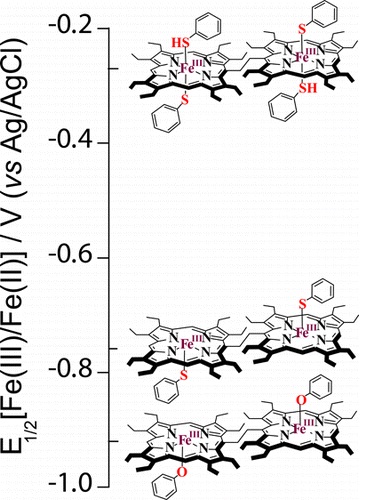
Synthesis, X-ray structures and properties of a series of diiron(III)bisporphyrin with axial thiophenolate coordination has been reported. The large difference in chemical and electrochemical properties of the dihemes as compared to the monoheme analogs provide an unequivocal evidence of the role played by inter-heme interactions.
63. Transfer and Control of Molecular Chirality in the 1:2 Host-Guest Supramolecular Complex Consisting of Mg(II) bisporphyrin and Chiral Diols: Effect of H-bonding on Rationalization of Chirality
Sk. A. Ikbal, S. Brahma and S. P. Rath*
Chem. Commun. 2014, 50, 14037-14040. Full Article

Chiral diol substrate binds to Mg(II)bisporphyrin in an unusual endo-endo fashion due to inter- ligand H-bonding which eventually results in remarkably high amplitude bisignate CD signal.
62. Highly Enhanced Bisignate Circular Dichroism of Ferrocene-Bridged Zn(II) Bisporphyrin Tweezer with Extended Chiral Substrates due to Well-matched Host-Guest System
S. Brahma, Sk. A. Ikbal, A. Dhamija and S. P. Rath*
Inorg. Chem. 2014, 53, 2381-2395. Full Article
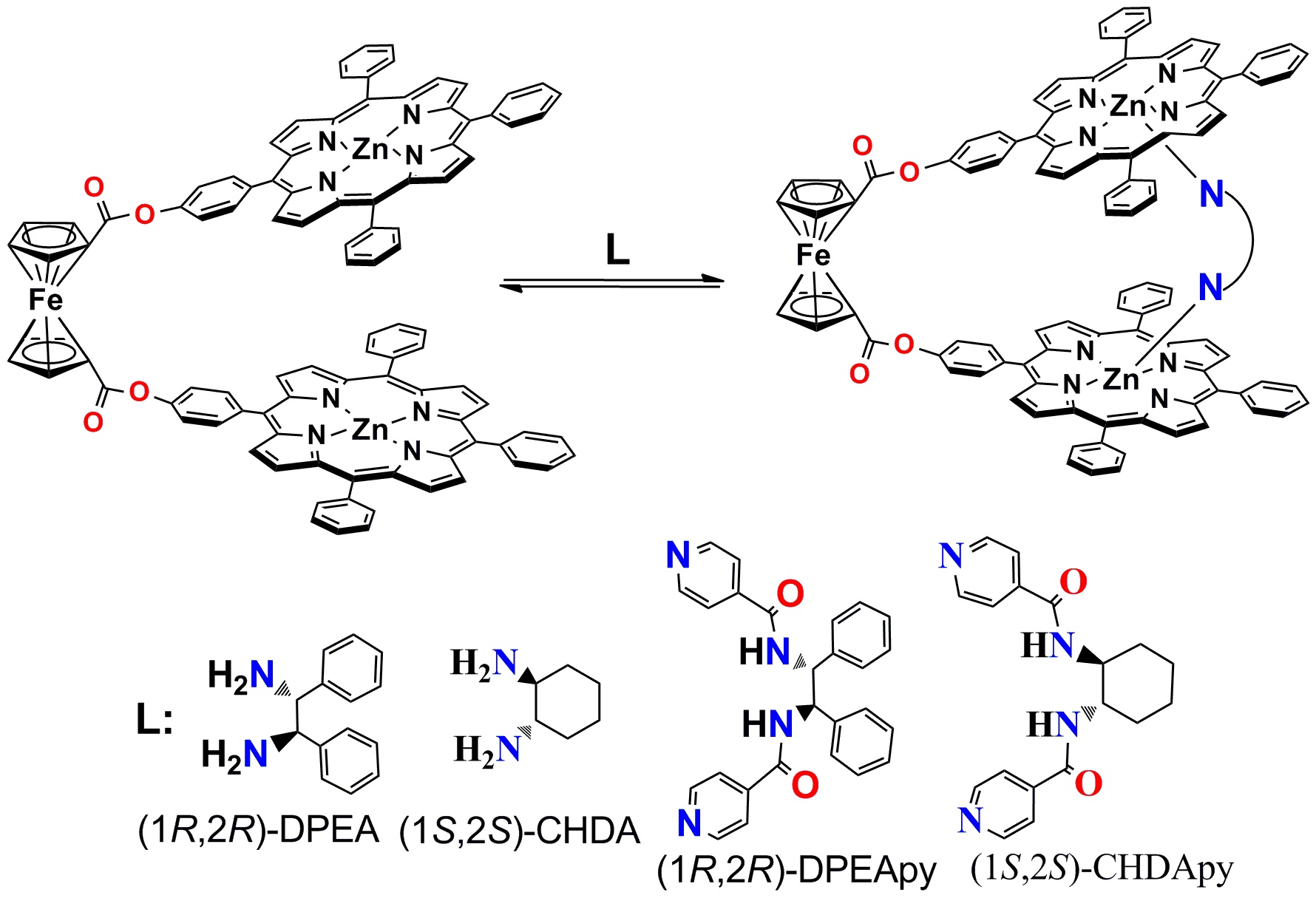

Four new supramolecular chiral tweezer-diamine complexes consisting of an achiral Zn(II)bisporhyrin host (green line) and two small chiral diamines, (1R,2R)-DPEA and (1S,2S)-CHDA, and two large extended chiral diamines, (1R,2R)-DPEApy and (1S,2S)-CHDApy, are reported. Complexes with extended chiral substrates show remarkably high amplitude of bisignate CD signal (blue-line) while smaller substrates show low value (red-line) with opposite sign of CD couplet.
61. Synthesis, Structure, and Properties of a Series of Chiral Tweezer-Diamine Complexes Consisting of an Achiral Zinc(II) Bisporphyrin Host and Chiral Diamine Guest: Induction and Rationalization of Supramolecular Chirality
S. Brahma, Sk. A. Ikbal and S. P. Rath*
Inorg. Chem. 2014, 53, 49-62. Full Article

A series of supramolecular chiral tweezers consisting of an achiral Zn(II)bisporphyrin host and variety of chiral diamine guests have been presented here which demonstrates a full and unambiguous rationalization of the chirality transfer process from the chiral guest to the achiral host observed in many natural and artificial supramolecular assemblies.
60. Syn-Anti Conformational Switching in an Ethane-bridged Co(II)bisporphyrin Induced by External Stimuli: Effects of Inter-macrocyclic Interactions, Axial Ligation and Chemical and Electrochemical Oxidations
S. Dey and S. P. Rath*
Dalton Trans. 2014, 43, 2301-2314. Full Article
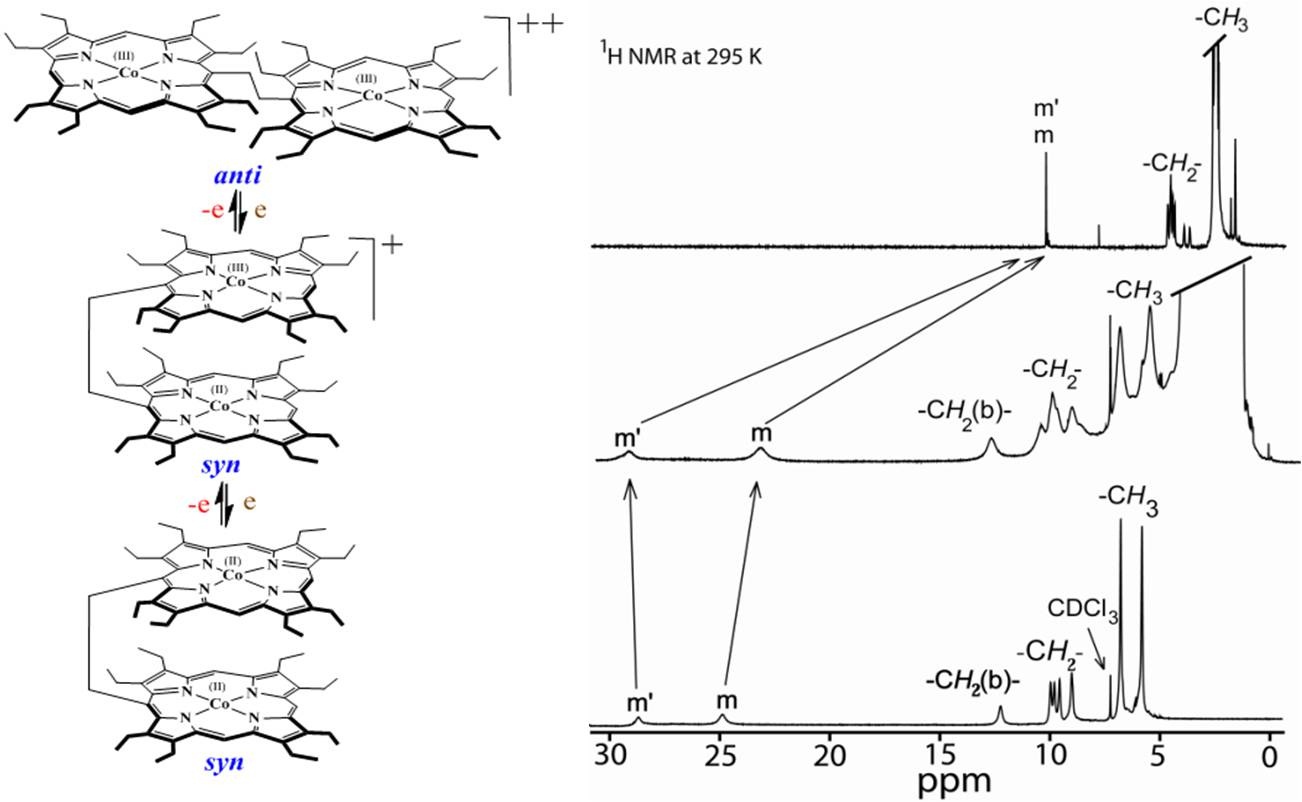
The reversible syn-anti conformational switching has been observed either by various external ligands or stepwise oxidations.
59. Iron(III) and Copper(II) complexes of trans-bis(ferrocenyl)porphyrin: effect of metal ions on long-range electronic communication
D. Sahoo and S. P. Rath*
J. Chem. Sci. 2014, 127, 327. Full Article (Invited article in a Special Issue on MTIC-XV)
58. Building-up Novel Coordination Polymer with Zn(II) Porphyrin Dimer: Synthesis, Structures, Surface Morphology and Effect of Axial Ligands
Sk. A. Ikbal, S. Brahma, A. Dhamija and S. P. Rath*
J. Chem. Sci. 2014, 126, 1451. Full Article (Invited article in the special issue on "Chemical Crystallography")
57. Unusual Stabilization of an Intermediate Spin of Iron upon Axial Phenoxide Coordination on a Diiron(III)bisporphyrin: Effect of Heme-Heme Interactions
S. Bhowmik, S. Dey and S. P. Rath*
Chem. Eur. J. 2013, 19, 13732-13744. Full Article
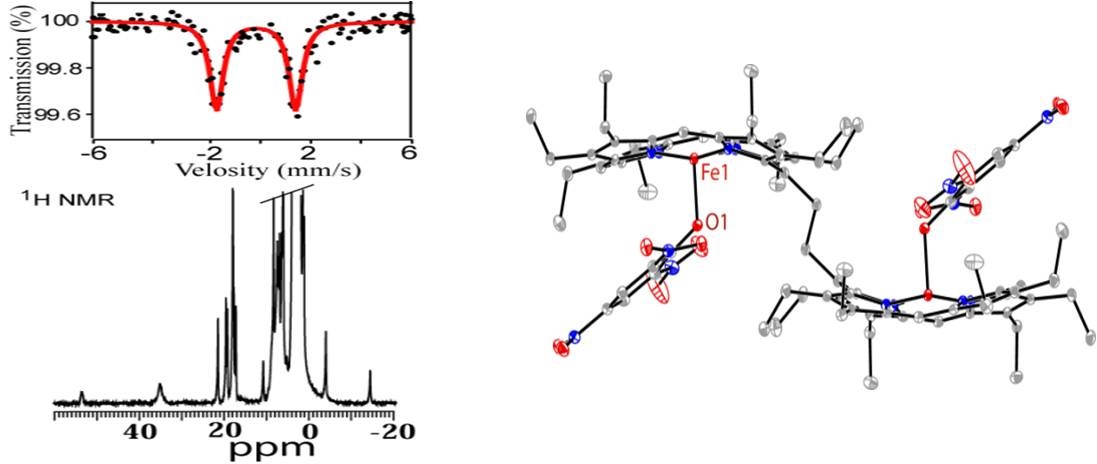
Spin city: Five new phenolate complexes of diiron(III)bisporphyrin, in which 2,4,6-trinitrophenol stabilizes the pure intermediate-spin state (S=3/2) of iron, are reported for the first time. Similar coordination with the corresponding FeIII monoporphyrin only resulted in stabilization of the high-spin state.
56. Self-assembly of Cobalt(II) and Zinc(II) Tetranitro Octaethylporphyrin via Bidentate Axial Ligands: Synthesis, Structure, Surface Morphology and Effect of Axial Coordination
S. Dey, Sk A. Ikbal and S. P. Rath*
New J. Chem. 2013, 37, 1458-1470.(Invited article)
55. Effect of Heme-Heme Interactions and Modulation of Metal Spins by Counter Anions in a Series of Diiron(III)-μ-hydroxo Bisporphyrins: Unusual Stabilization of Two Different Spins in a Single Molecular Framework
S. K. Ghosh, S. Bhowmik and S. P. Rath*
Chem. Eur. J. 2013, 19, 17846-17859. Full Article
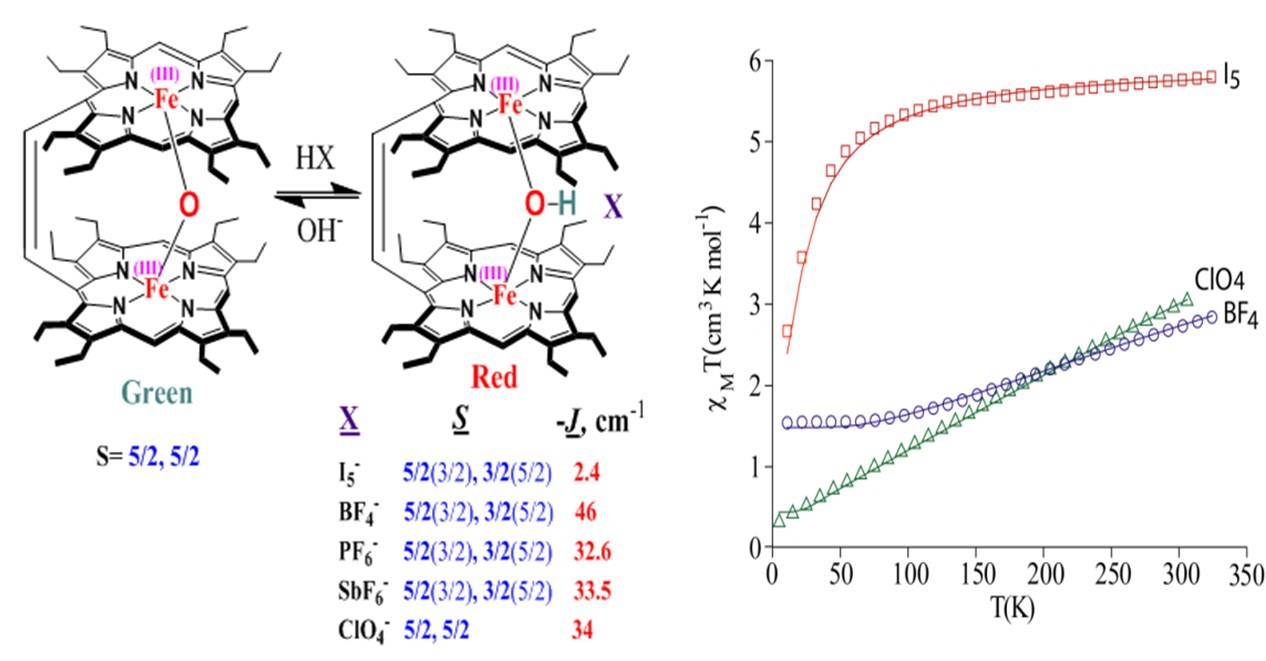
Anion effect on diiron-bisporphyrin properties: A new family of five ethene-bridged diiron(III)-μ-hydroxo bisporphyrins with the same core structure but different counter anions is reported herein. In these complexes, two different spin states of Fe are stabilized in a single molecular framework.
54. Supramolecular BODIPY-Zn(II)-Bisporphyrin Dyad and Trinitrofluorenone Encapsulated Triad as Models of Antenna-reaction Center: Synthesis, Structure and Photophysical Properties
P. Mondal, A. Chaudhary and S. P. Rath*
Dalton Trans. 2013, 42, 12381-12394. Full Article

We describe the
synthesis, characterization and photophysical properties of the dyads Zn2DEP·TNF
(1) and Zn2DEP·2Py-BDP
(2) and triad Zn2DEP·2Py-BDP·TNF
(3), which enable us to investigate the changes in
the spectroscopic properties upon the axial coordination of
53. Formation of exo-exo, exo-endo and tweezer conformation induced by axial ligand in a Zn(II) bisporphyrin: Synthesis, structure and property
A. Chaudhary, Sk. A. Ikbal, S. Brahma and S. P. Rath*
Polyhedron 2013, 52, 761-769. Full Article (Invited article in a special volume dedicated to Alfred Werner on the 100th Anniversary of his Nobel Prize in Chemistry in 1913)
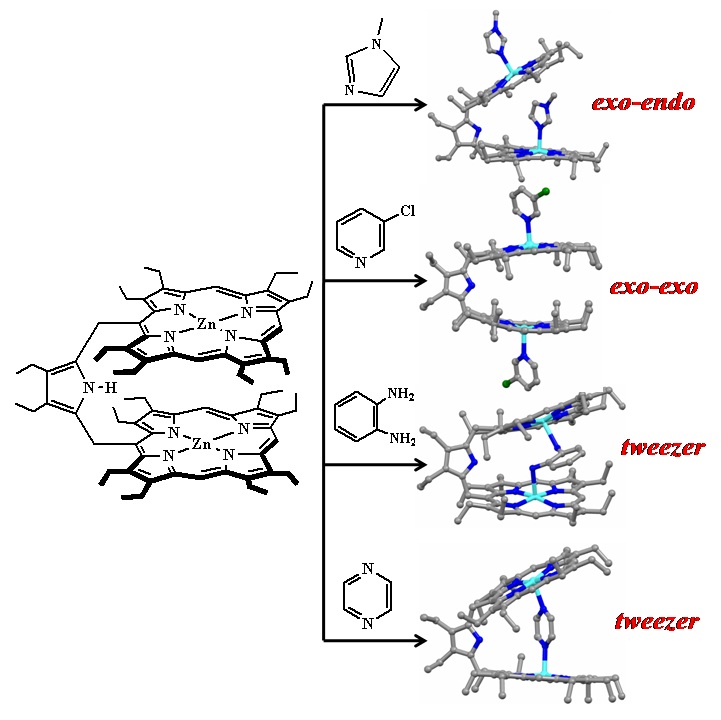
A detailed structural and spectroscopic investigation of axial ligand coordination on Zinc(II)pyrrole-bridged bisporphyrin (Zn2DEP), have been reported. Our findings demonstrate that the DEP system provides a Pacman pocket with very high vertical and horizontal flexibility that leads to the formation of exo-endo, exo-exo and tweezer complexes of Zn(II)(bisporphyrinato), for the first time in the solid state, depending upon the size and type of axial ligands used.
52. Switching Orientation of Two Axial Imidazole Ligands between Parallel and Perpendicular in Low-Spin Fe(III) and Fe(II) Nonplanar Porphyrinates
R. Patra, D. Sahoo, S. Dey, D. Sil and S. P. Rath*
Inorg. Chem. 2012, 51, 11294-11305. Full Article
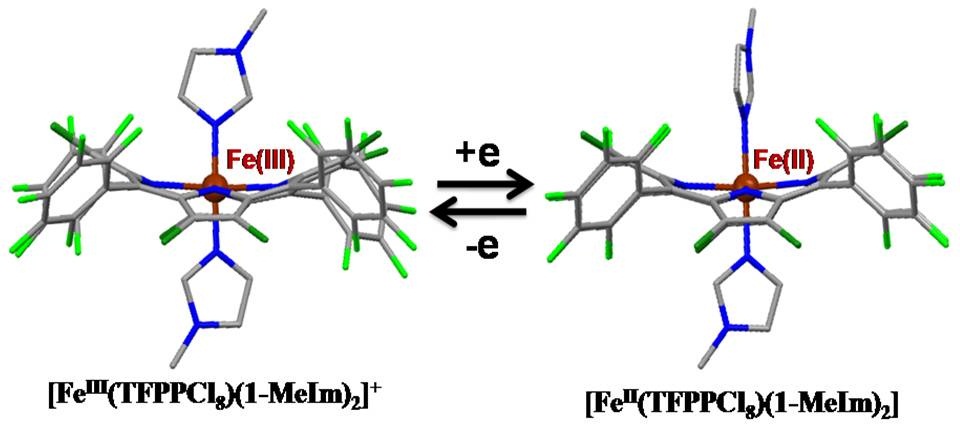
Bis-imidazole-coordinated Fe(III) and Fe(II) porphyrin changes the axial ligand orientation from parallel to perpendicular, respectively, in a nonplanar porphyrinic environment.
51. Building-up Remarkably Stable Magnesium Porphyrin Polymers Self-assembled via Bidentate Axial Ligands: Synthesis, Structure, Surface Morphology and Effect of Bridging Ligands
Sk. A. Ikbal, S. Brahma and S. P. Rath*
Inorg. Chem. 2012, 51, 9666-9676. Full Article
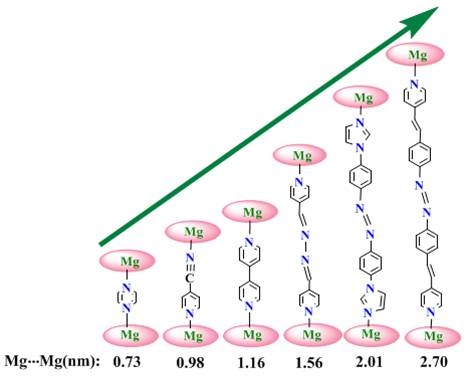
A series of remarkably stable magnesium porphyrin polymers bridged by large bidentate axial ligands, have been synthesized in one pot in excellent yields and structurally characterized. The surface patterns on HOPG have also been investigated.
50. Protonation of an oxo-Bridged Diiron Unit Makes Two Iron Centers Different: A New Class of Diiron(III)-μ-hydroxo Bisporphyrin and Control of Spins by Counter Anions
S. Bhowmik, S. K. Ghosh and S. P. Rath*
Chem. Eur. J. 2012, 18, 13025-13037. Full Article
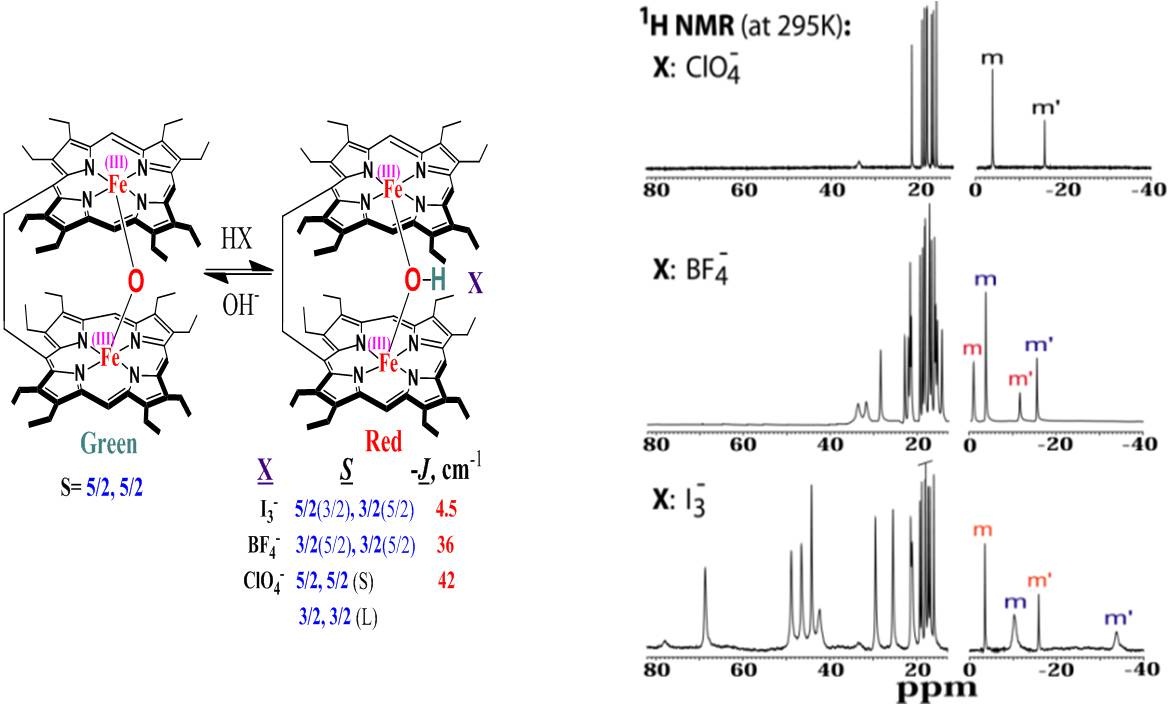
The core of the matter: A previously unknown family of diiron(III)-μ-hydroxo bisporphyrins in which two different spin states of Fe are stabilized in a single molecular framework, even though both cores have identical molecular structures, is presented. The spin states were found to be dependent on the counterion.
49. Induction of Supramolecular Chirality in Di-Zinc(II) Bisporphyrin via Tweezer Formation: Synthesis, Structure and Rationalization of Chirality
S. Brahma, Sk. A. Ikbal, S. Dey and S. P. Rath*
Chem. Commun. 2012, 48, 4070-4072. Full Article (Invited article in a special thematic issue 'Porphyrins and Phthalocyanines')
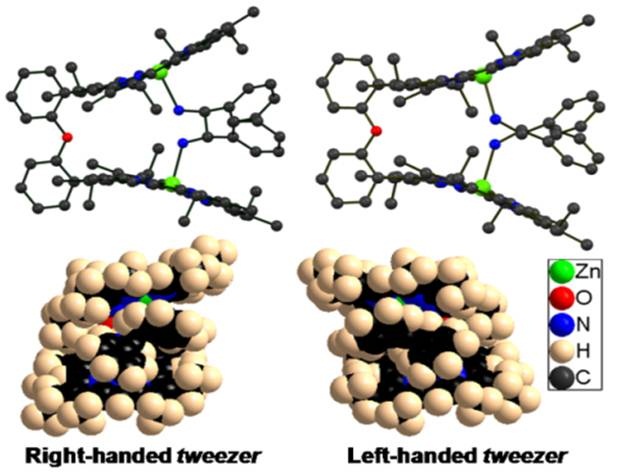
Two new supramolecular complexes consisting of an achiral bisporphyrin host and a chiral diamine guest are reported. One shows remarkably high amplitude of bisignate CD signal while other one shows very low value.
48. Encapsulation of TCNQ and Acridinium Ion within Bisporphyrin Cavity: Synthesis, Structure, Photophysical and HOMO-LUMO Gap Mediated Electron Transfer Properties
A. Chaudhary and S. P. Rath*
Chem. Eur. J. 2012, 18, 7404-7417. Full Article

Donor-acceptor complexes: Donor–acceptor complexes, which were constructed from free base bisporphyrin (H4DEP) as a host, strongly encapsulated two electron-deficient guests, TCNQ and the acridinium ion, in its clefts. The extremely low electrochemically evaluated HOMO–LUMO gap in H4DEP•TCNQ led to facile electron transfer from the host to the guest at room temperature, whilst partial electron transfer took place in [H4DEP•AcH]ClO4.
47. Efficient Complexation of Pyrrole-bridged Di-Zinc(II) Bisporphyrin with Fluorescent Probe Pyrene: Synthesis, Structure, and Photoinduced Singlet-Singlet Energy Transfer
A. Chaudhary and S. P. Rath*
Chem. Eur. J. 2011, 17, 11478-11487. Full Article
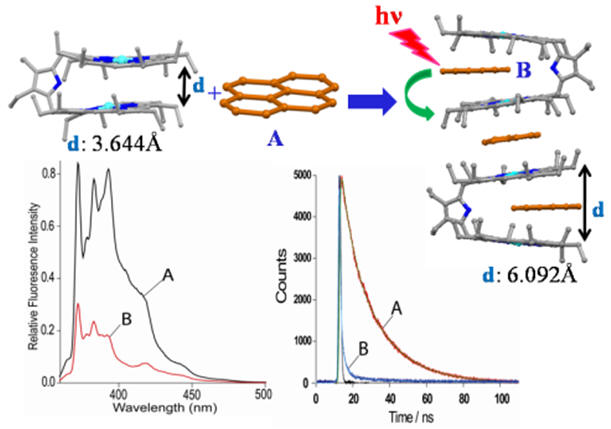
Fluoroscent guest! : A dizinc(II) bisporphyrin encapsulates the fluorescent probe pyrene (guest) within the bisporphyrin clefts. The solid-state assembly is very robust in solution for days. Spectroscopic studies indicate significant photoinduced singlet–singlet energy transformation from guest to host.
46. Magnesium inserted porphyrin compound, its blends and devices thereof
S. S. K. Iyer, S. P. Rath, A. Singh and Sk. A. Ikbal
Patent Application No. 3272/DEL/2011 dated November 17, 2011.
45. Control of Spins by Ring Deformation in a Diiron(III)bisporphyrin: Reversal of ClO4- and CF3SO3- Ligand Field Strength on the Magnetochemical Series
S. Bhowmik, S. K. Ghosh and S. P. Rath*
Chem. Commun. 2011, 47, 4790-4792. Full Article

The complete reversal of the ligand field strength between ClO4- and CF3SO3- on the ‘magnetochemical’ series is observed in a diiron(III)bisporphyrin. While ClO4- gives typical high-spin complex, just by twisting the conformation of the macrocycle shows properties with pure intermediate-spin state with CF3SO3- although the axial ligand strengths suggest the reverse order of spin stabilization.
44. Axial Phenoxide Coordination on Di-Iron(III)bisporphyrin: Insights from Experimental and DFT Studies
S. Bhowmik, D. Sil, R. Patra and S. P. Rath*
J. Chem. Sci. 2011, 123, 827. (Invited article in the Special Issue of International Year of Chemistry)
43. Syn-anti Conformational Switching: Synthesis and X-ray Structures of Tweezer and Anti Form in a Zinc Porphyrin Dimer Induced by Axial Ligands
S. Brahma, Sk. A. Ikbal and S. P. Rath*
Inorg. Chim. Acta. 2011, 372, 62-70. Full Article (Invited article in the Special Volume dedicated to Professor S. S. Krishnamurthy on the occasion of his 70th birth anniversary)
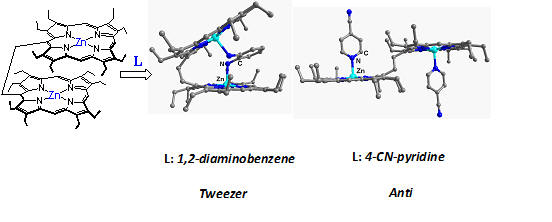
42. Models for the Photosynthetic Reaction Center: Synthesis, Structure, and Electrochemical Properties of a Cofacial Di-palladium Bisporphyrin
A. Chaudhary, R. Patra and S. P. Rath*
Indian J. Chem., Sec. A. 2011, 50, 1436. (Invited article in the Special Issue dedicated to Acharya Prafulla Chandra Ray on the occasion of his 150th birth anniversary).
41. Synthesis, Structure and Properties of a High-Spin Fe(III) Porphyrin with Nonequivalent Axial Ligands: Implications for the Hemoproteins
A. Chaudhary, R. Patra, and S. P. Rath*
Indian J. Chem., Sec. A. 2011, 432. (Invited article in the Special Issue on Bioinorganic Chemistry dedicated to Professor S. Mitra on the occasion of his 70th birth anniversary).
40. A Remarkably Bent Diiron(III)-μ-Hydroxo Bisporphyrin: Unusual Stabilization of Two Spin States of Iron in a Single Molecular Framework
S. K. Ghosh and S. P. Rath*
J. Am. Chem. Soc. 2010, 132, 17983-17985. Full Article
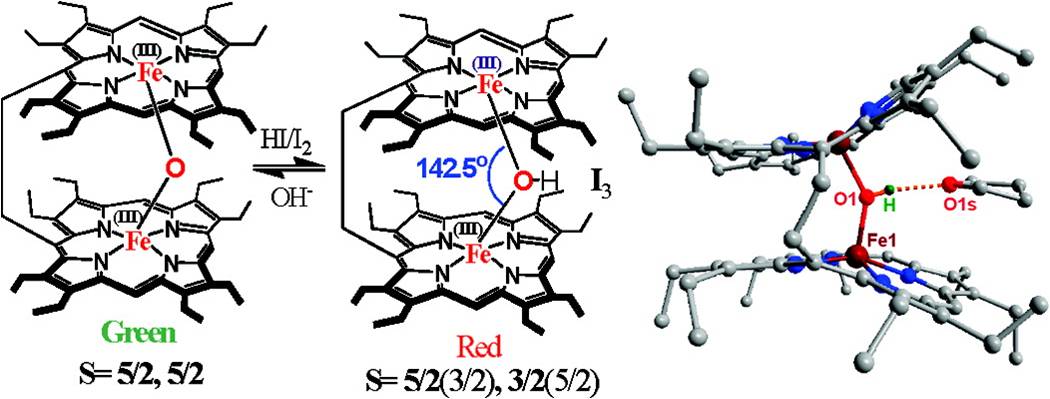
A novel diiron(III) bisporphyrin bridged by a single hydroxo group between two Fe-centers is reported in which the Fe-O(H)-Fe angle becomes the smallest ever reported in a Fe-porphyrin and two different spin states of Fe are stabilized in a single molecular framework, for the first time, although both cores have exactly the same chemical entity.
39. Binding of Catechols to Iron(III) Octaethyl Porphyrin: An Experimental and DFT Investigation
A. Chaudhury, R. Patra and S. P. Rath*
Eur. J. Inorg. Chem. 2010, 5211-5221. Full Article
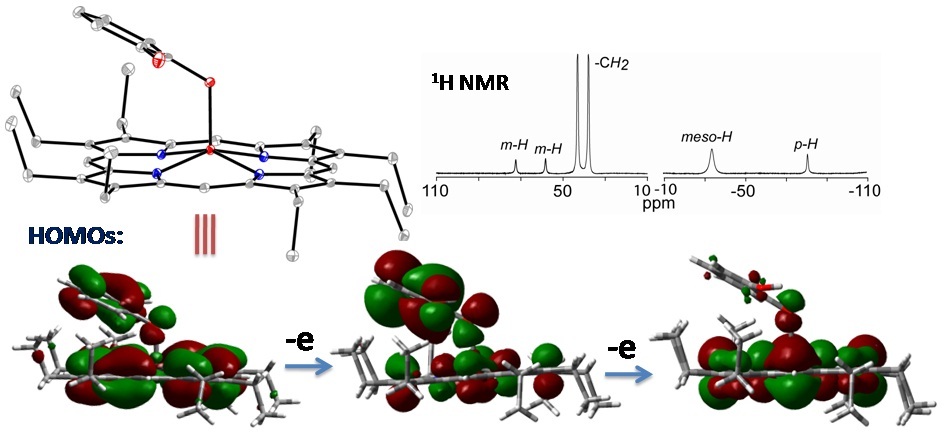
The synthesis, X-ray structures, and properties of new heme analogues FeIII(OEP)(L) (L: Hcat, 4-NO2-Hcat, 4-tBu-Hcat, and sal) are reported, in which catechol binds in an η1-fashion as an axialligand. Spectroelectrochemical studies of one- and two-electron oxidations are also reported. Experimental findings are supported by DFT calculations.
38. Effects of Axial Pyridine Coordination in a Saddle-Distorted Porphyrin macrocycle: Stabilization of Hexa-coordinated High-Spin Fe(III) and Air-stable Low-Spin Iron(II) Porphyrinates
R. Patra, S. Bhowmik, S. K. Ghosh and S. P. Rath*
Dalton Trans. 2010, 39, 5795-5806. Full Article

We have reported here
the effect of axial ligand L (L:
37. Synthesis, Structure and Photocatalytic Activity of a Remarkably Bent, Cofacial Ethene-linked Diiron(III) μ-oxobisporphyrin
S. K. Ghosh, R. Patra and S. P. Rath*
Inorg. Chim. Acta. 2010, 363, 2791-2799. Full Article (Invited article in the Special Volume dedicated to Professor A. Chakravorty on the occasion of his 75th birth anniversary)
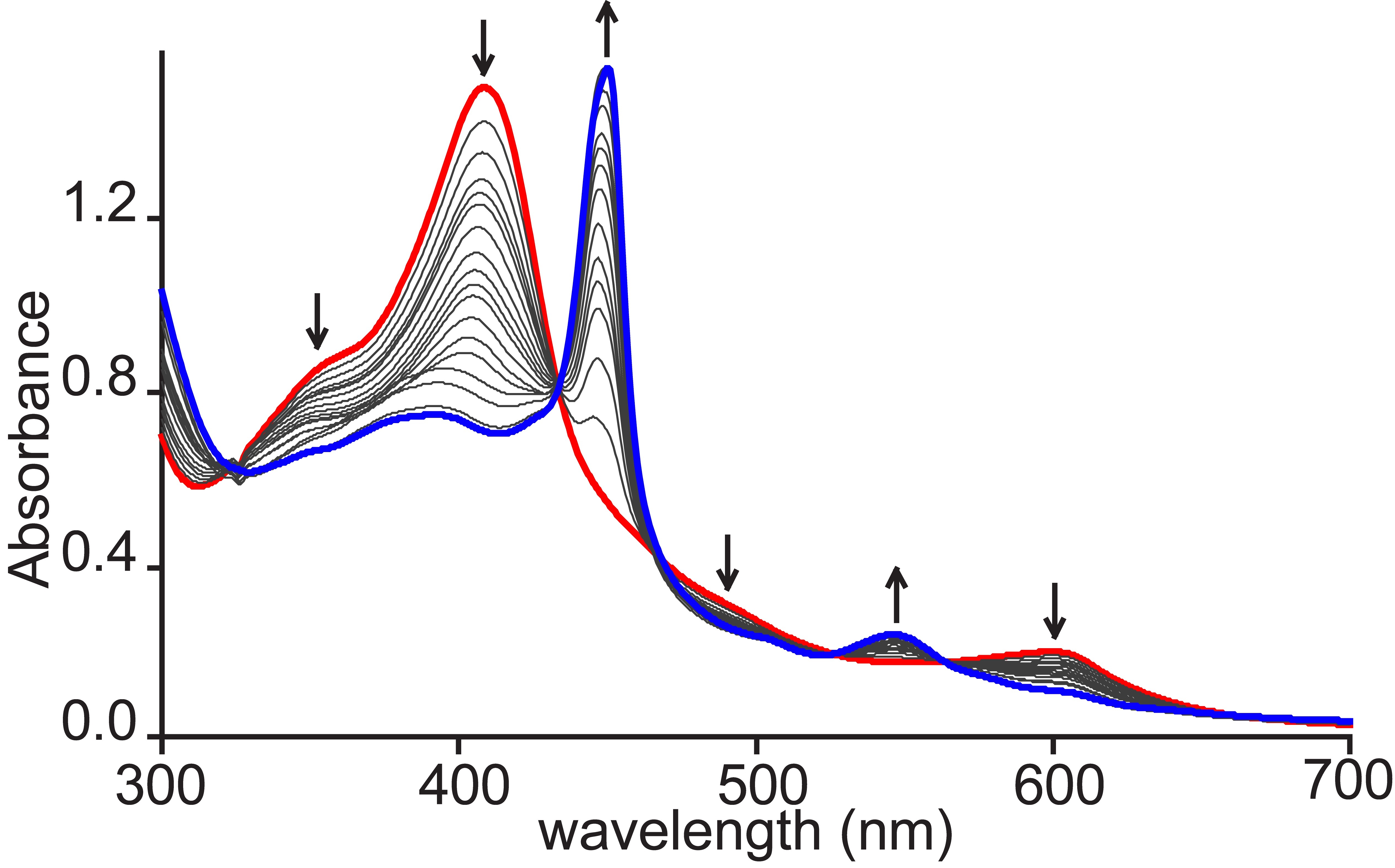
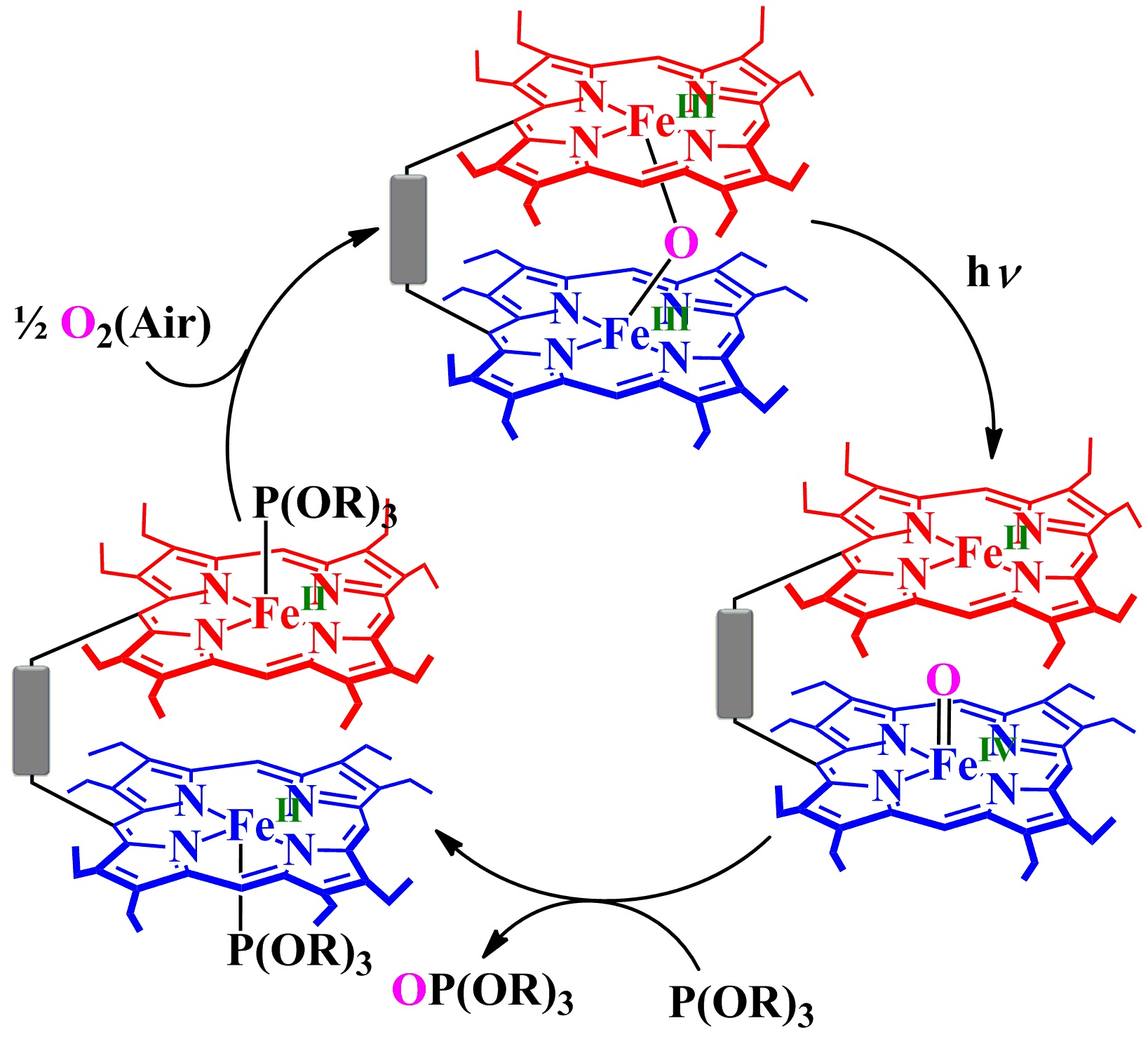
A remarkably bent diFe(III)-μ-oxo bisporphyrin with Fe-O-Fe angles of 150.9(2)° is reported in which the bisporphyrin platform ‘open’ and ‘close’ its binding pockets reversibly with very high vertical flexibility. The complex is thermally very inert but undergo prompt photocatalytic oxidation when photolyzed with excess phosphites in benzene under mild condition using aerial oxygen.
36. Synthesis and Characterization of anti-bisFe(III) Porphyrins, syn-bisFe(III)-μ-oxo Porphyrin and syn-bisFe(III)-μ-oxo Porphyrin Cation Radical
S. K. Ghosh, R. Patra and S. P. Rath*
Inorg. Chem. 2010, 49, 3449-3460. Full Article

BisFe(III) porphyrins containing highly flexible ethane linker are reported in which the bisporphyrin platform ‘open’ and ‘close’ its binding pockets leading to facile syn-anti conformational switching with very high vertical flexibility in a single molecular framework.
35. Axial Ligand Orientations in a Distorted Porphyrin Macrocycle: Synthesis, Structure and Properties of Low-Spin bis (Imidazole) Fe(III) and Fe(II) porphyrinates
R. Patra, A. Chaudhary, S. K. Ghosh and S. P. Rath*
Inorg. Chem. 2010, 49, 2057-2067. Full Article
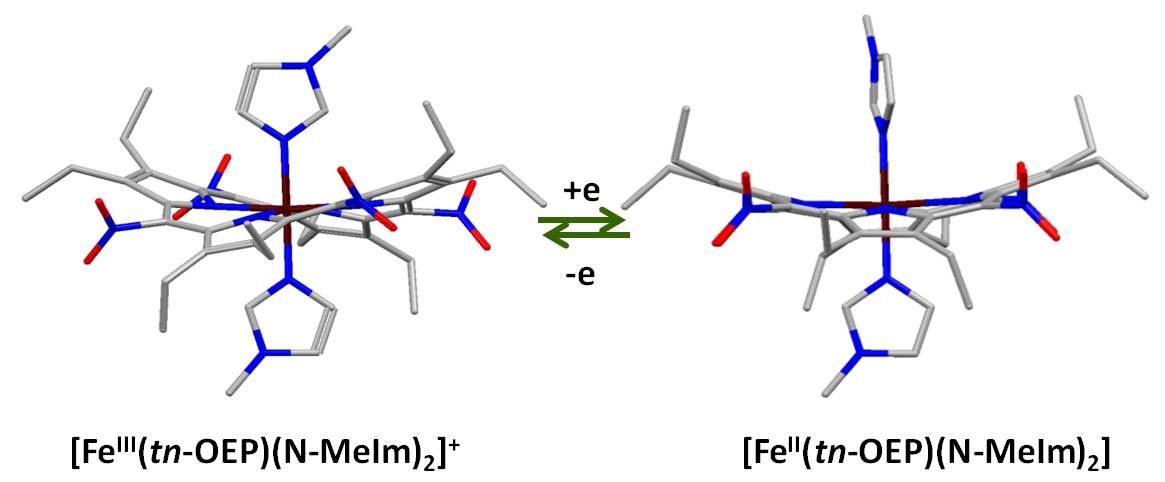

Iron(II) and iron(III) tetranitrooctaethylporphyrinates coordinated with two planar and unhindered imidazoles as axial ligand have nearly perpendicular and parallel orientation preferences, respectively, in a nonplanar porphyrinic environment.
34. Cyanide binding to iron in a highly distorted porphyrin macrocycle: Synthesis and structure of low-spin Fe(II) dicyano porphyrin
R. Patra and S. P. Rath*
Inorg. Chem. Commun. 2009, 515-519. Full Article
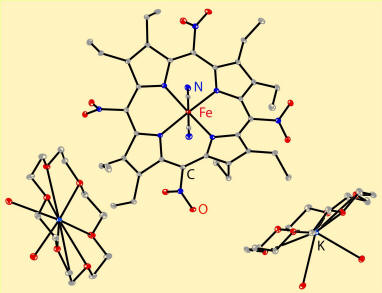
[K(18-crown-6)(H2O)2]2[FeII(tn-OEP)(CN)2] represents the first structurally characterized Fe(II) dicyano porphyrins in a highly distorted macocyclic environment. The metal iron is on the plane of the four porphyrinic nitrogens which are accompanied by the decrease of the saddle distortion with a clear and significant increase in ruffling.
33. The Effect of Steric Crowding on Porphyrin Conformation and Ring Orientations in a Series of Iron(III) μ-Oxo Dimers Containing meso-Nitrooctaethylporphyrins
R. Patra, S. Bhowmik, S. K. Ghosh and S. P. Rath*
Eur. J. Inorg. Chem. 2009, 5, 654-665. Full Article
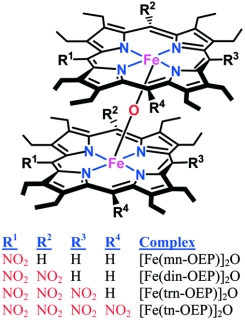
The structural and electronic effects of the progressive addition of bulky and electron-withdrawing NO2 groups at the adjacent meso carbon positions of FeIII-μ-oxo octaethylporphyrin dimers are examined.
32. Modulation of metal displacement in a saddle distorted macrocycle: synthesis, structure and properties of high spin Fe(III) porphyrins and implications for the hemoprotiens
R. Patra, A. Chaudhary, S. K. Ghosh and S. P. Rath*
Inorg. Chem. 2008, 47, 8324-8335. Full Article
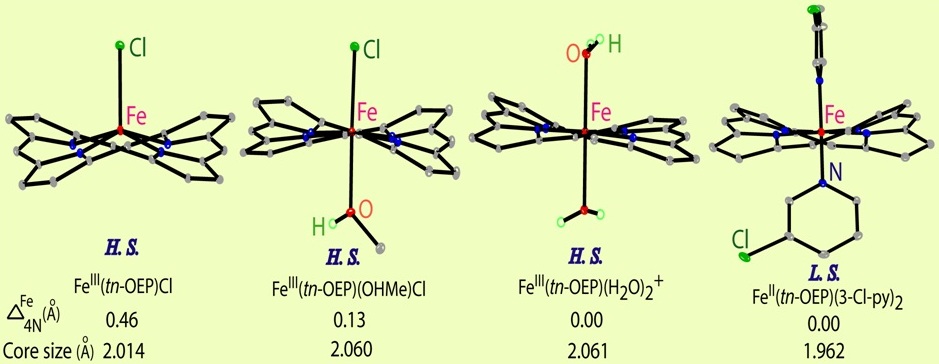
A rare family of five and six-coordinated high-spin Fe(III) porphyrins incorporating weak axial ligands are synthesized and structurally characterized which demonstrates, for the first time, step-wise metal displacements in a single distorted macrocyclic environment that has generally been seen in many biological systems.
31. Remarkably Bent, Ethane-Linked, Diiron(III) μ-Oxobisporphyrin: Synthesis, Structure, Conformational Switching, and Photocatalytic Oxidation
S. K. Ghosh, R. Patra and S. P. Rath*
Inorg. Chem. 2008, 47, 10196-10198. Full Article
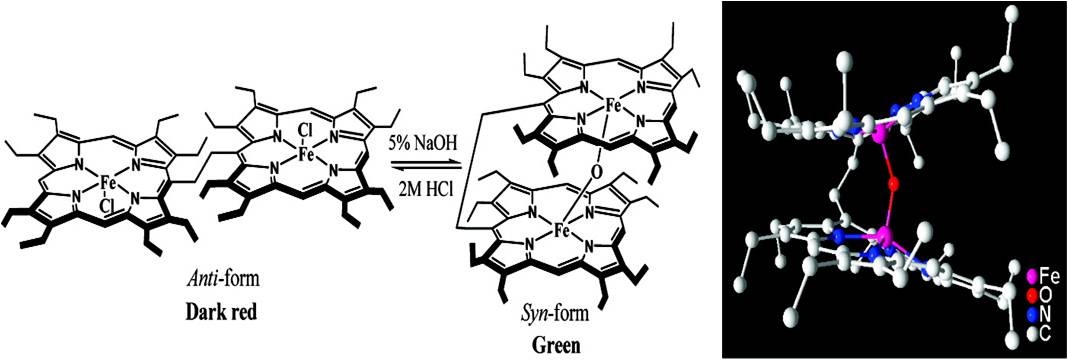
A remarkably bent bisFe(III)-μ-oxo porphyrin with Fe-O-Fe angles of 147.9(1)º containing highly flexible ethane linker is reported which authenticates, for the first time, the unprecedented ability of the bisporphyrin platform to ‘open’ and ‘close’ its binding pockets leading to facile syn-anti conformational switching with very high vertical flexibility of over 6.5Å in a single molecular framework.
30. Axial Ligand Coordination in Sterically Strained Vanadyl Porphyrins: Synthesis, Structure, and Properties
S. K. Ghosh, R. Patra and S. P. Rath*
Inorg. Chem. 2008, 47, 9848-9856. Full Article
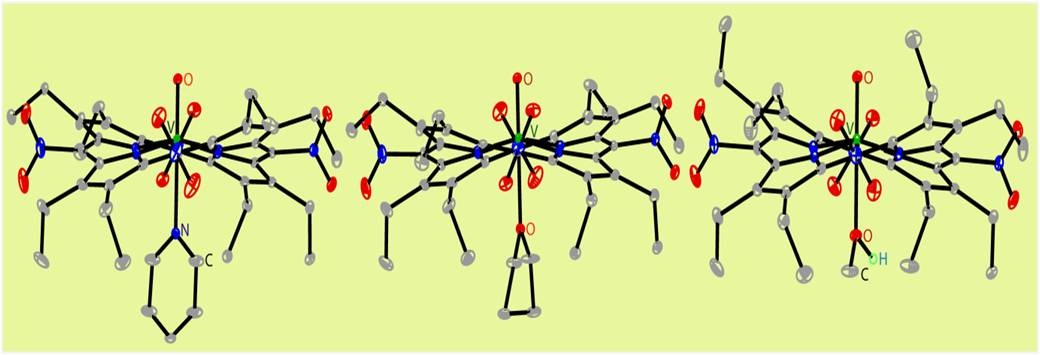
A hitherto unknown family of six-coordinate vanadyl porphyrins of the sterically crowded, nonplanar 2,3,7,8,12,13,17,18-octaethyl-5,10,15,20-tetranitroporphyrin incorporating axial ligand L (L: pyridine, THF and MeOH), have been isolated as VO(tn-OEP)(L) in the solid phase for the first time and structurally characterized as shown.
29. Electronic Structure of the Glyoxalbis(2-hydroxyanil) (gha) Ligand in [CoIII(gha)(PPh3)2]+: Radical vs. Non-radical States
A. S. Roy, N. Muresan, H. M. Tuononen, S. P. Rath, P. Ghosh
Dalton Trans. 2008, 26, 3438.
28. First Ruthenium Complex of Glyoxalbis(N-phenyl)osazone (LNHPhH2): Synthesis, X-ray Structure, Spectra, and Density Functional Theory Calculations of (LNHPhH2)Ru(PPh3)2Cl2
A. S. Roy, H. M. Tuononen, S. P. Rath, P. Ghosh
Inorg. Chem. 2007, 46, 5942.
27. Dioxygen Reactivity of Meso-hydroxylated Hemes: Intermediates in Heme Degradation Process Catalyzed by Heme-oxygenase.
S. P. Rath*
J. Chem. Sci. 2006, 118, 463.
26. Electron Distribution in Octaethyloxophlorin Complexes. Importance of the Fe(III) Oxophlorin Trianion Form in the Bis-pyridine and Bis-imidazole Complexes
S. P. Rath, M. M. Olmstead and A. L. Balch
Inorg. Chem. 2006, 45, 6083.
25. Metal Complexes of meso-Amino-octaethylporphyrin and the Oxidation of Ni(II)(meso-amino-octaethylporphyrin)
N. Sprutta, S. P. Rath, M. M. Olmstead and A. L. Balch
Inorg. Chem. 2005, 44, 1452.
24. Pyramidalization of Gd3N inside a C80 Cage. The Synthesis and Structure of Gd3N@C80
S. Stevenson, J. P. Stevenson, J. E. Reid, M. M. Olmstead, S. P. Rath and A. L. Balch
Chem. Commun. 2004, 2814.
23. Oxidative Verdoheme Formation and Stabilization by Axial Isocyanide Ligation
S. P. Rath, M. M. Olmstead and A. L. Balch
Inorg. Chem. 2004, 43, 7648.
22. Reaction of Meso-hydroxyhemes with Carbon Monoxide and Reducing Agents in Search of the Elusive Species Responsible for the g=2.006 Resonance of Carbon Monoxide Treated Heme Oxygenase. Isolation of Diamagnetic Iron(II) Complexes of Octaethyl meso-hydroxyporphyrin
S. P. Rath, M. M. Olmstead and A. L. Balch
Inorg. Chem. 2004, 43, 6357.
21. Formation of a Highly Oxidized Iron Biliverdin Complex Upon Treatment of a Five-coordinate Verdoheme with Dioxygen
K. T. Nguyen, S. P. Rath, L. Latos-Grazynski, M. M. Olmstead and A. L. Balch
J. Am. Chem. Soc. 2004, 126, 6210.
20. The Effect of Axial Ligands on Spin States and Electron Distribution in Iron Complexes of Octaethyloxophlorin, Intermediates in Heme Degradation
S. P. Rath, M. M. Olmstead and A. L. Balch
J. Am. Chem. Soc. 2004, 126, 6379.
19. A Novel Pentacoordinated Dioxovanadium(V) Salicylaldiminate: Solvent Specific Crystalisation of Dimorphs with Contrasting Coordination Geometries, Ligand Conformations and Supramolecular Architectures
B. Baruah, S. P. Rath and A. Chakravorty
Eur. J. Inorg. Chem. 2004, 1873.
18. Facile Ring Opening of Iron(III) and Iron (II) Complexes of meso-Amino-octaethylporphyrin by Dioxygen
S. P. Rath, H. Kalish, L. Latos-Grazynski, M. M. Olmstead and A. L. Balch
J. Am. Chem. Soc. 2004, 126, 646.
17. Formation and Isolation of an Iron-Tripyrrole Complex from Heme Degradation
S. P. Rath, M. M. Olmstead, L. Latos-Grazynski and A. L. Balch
J. Am. Chem. Soc. 2003, 125, 12678.
16. Reversible Binding of Nitric Oxide and Carbon-Carbon Bond Formation in a Meso-Hydroxylated Heme
S. P. Rath, R. Koerner, M. M. Olmstead and A. L. Balch
J. Am. Chem. Soc. 2003, 125, 11798.
15. Heme Cleavage with Remarkable Ease: Paramagnatic Intermediates Formed by Aerial Oxidation of a Meso-Amino-Substituted Iron Porphyrin
H. Kalish, H. M. Lee, M. M. Olmstead, L. Latos-Grazynski, S. P. Rath and A. L. Balch
J. Am. Chem. Soc. 2003, 125, 4674.
14. Synthesis, structure and properities of mononuclear oxovanadium(V) alkoxides incorporating chelated ethane-1,2-diol and propane-1,3-diol
K. K. Rajak, S. Mondal and S. P. Rath
Polyhedron 2000, 19, 931.
13. Sugar Binding to VO3+. Synthesis and Structure of a New Mannopyranoside Vanadate
K. K. Rajak, B. Baruah, S. P. Rath and A. Chakravorty
Inorg. Chem. 2000, 39, 1598.
12. Ruthenium dithiophosphates: Synthesis, X-ray crystal structure, spectroscopic and electrochemical properties
P. U. Jain, P. Munshi, M. G. Walawalkar, S. P. Rath, K. K. Rajak and G. K. Lahiri
Polyhedron 2000, 19, 801.
11. Synthesis, Structure and Catecholase Reaction of a Vanadate Ester System Incorporating Monoionized Catechol Chelation
S. P. Rath, K. K. Rajak and A. Chakravorty
Inorg. Chem. 1999, 38, 4376.
10. Carbohydrate Binding to VO3+. Sugar Vanadate Esters Incorporating L-Amino Acid Schiff Bases as Coligands
K. K. Rajak, S. P. Rath, S. Mondal and A. Chakravorty
Inorg. Chem. 1999, 38, 3283.
9. Sugar vanadates: synthesis and characterisation of mannopyranoside and ribofuranoside esters incorporating VO3+
K. K. Rajak, S. P. Rath, S. Mondal and A. Chakravorty
J. Chem. Soc., Dalton Trans 1999, 2537.
8. Sugar vanadates : Synthesis and characterisation of a mannopyranoside ester incorporating VO3+
K. K. Rajak, S. P. Rath, S. Mondal and A. Chakravorty
Indian J. Chem. 1999, 38A, 405.
7. A Family of (N-Salicylidene-a-aminoacidato)Vanadate Esters Incorporating Propane-1,3-diol and Glycerol: Synthesis, Structure and Reaction
S. Mondal, S. P. Rath, K. K. Rajak and A. Chakravorty
Inorg. Chem. 1998, 37, 1713.
6. Synthesis and Structure of Vanadate Esters of Glycerol and Propane-1,3-diol
S. P. Rath, K. K. Rajak, S. Mondal and A. Chakravorty
J. Chem. Soc., Dalton Trans 1998, 2097.
5. Chemistry of Hydrazonato Oxovanadium(V) Alkoxides Derived from Dihydric/ Monohydric Alkohols
S. P. Rath, S. Mondal and A. Chakravorty
Inorg. Chim. Acta (R. H. Holm Issue) 1997, 263, 247.
4. Synthesis, Structure and Metal Redox of Alkoxide Bound Oxovanadium(V) Complexes Incorporating N-salicylidene/N-naphthalidene-a-aminoalcohols
S. P. Rath, T. Ghosh and S. Mondal
Polyhedron 1997, 16, 4179.
3. Chemistry of Oxovanadium(V) Alkoxides: Synthesis and Structure of Mononuclear Complexes Incorporating Ethane-1,2-diol
S. Mondal, S. P. Rath, S. Dutta and A. Chakravorty
J. Chem. Soc., Dalton Trans 1996, 99.
2. Mixed-Ligand Oxovanadium(V) Complexes Incorporating Bidentate Salicylaldehyde and Tridentate Aldimine Ligands
S. P. Rath, S. Mondal and T. Ghosh
Transition Met. Chem. 1996, 21, 309.
1. Water Soluble Mixed-Ligand Oxovanadium(IV) Complexes of Acetylacetone and Aldimine Ligands
S. P. Rath, S. Mondal and T. Ghosh
Indian J. Chem. 1996, 35A, 527.
| 2025 |

